Karl Shuker's Blog, page 20
February 28, 2019
A TENACIOUS PTERODACTYL, OR A CRYPTIC CANARD? RECALLING A CLASSIC CASE OF INFAMOUS IMMOLATION!
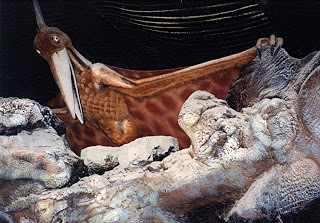 Did a living pterodactyl emerge from a blasted-apart hollow boulder in 19th-Century France? (© Dr Karl Shuker)
Did a living pterodactyl emerge from a blasted-apart hollow boulder in 19th-Century France? (© Dr Karl Shuker)It can be all too easy to forget sometimes that just because in over 40 years of researching and writing about all manner of animal anomalies I have encountered one or other tall story countless times, there are many younger enthusiasts out there who are discovering it for the very first time and are naturally very excited by it, not being aware of its full history and denouement.
I was reminded of this recently when I received an email from a youthful cryptozoology fan who had just read what he considered to be an awesome 19th-Century report announcing the discovery of an allegedly long-entombed but still-living pterodactyl in France. I first learned about this (in)famous incident of entombment or immolation more than four decades ago, at the beginning of my own career in cryptozoological research, when Fortean Times recalled it in the form of a delightful comic-strip presentation drawn by FT's inestimable artist-in-residence, the wonderful Hunt Emerson. So yes, there was a time in my life when I had not previously encountered this case either. Bearing that in mind, therefore, I've decided that it merits a retelling after all, and so, for my youthful correspondent and other first-timers, here it is.
According to an Illustrated London News report for 9 February 1856, a pterodactyl had supposedly emerged, weak but nonetheless alive, from out of a hollow boulder blasted apart during the then-recent excavation of a new railway tunnel at Culmont, in France. As soon as it took its first breath of air, however, it promptly expired. Although it has been repeated ad infinitum ever since in books, articles, and websites, this startling ILN report is rarely if ever reproduced directly in its original typeset form, so I am duly presenting it herewith, complete with its decidedly bizarre, mystifying title. (If anyone can explain to me why in this report's title the pterodactyl was likened to a whale, I'd be extremely grateful. Is it a now-obscure 19th-Century idiom that actually had connotations very different from its primary, literal meaning? I have absolutely no idea.)
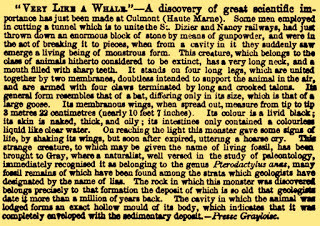 The complete entombed-pterodactyl report as it originally appeared on p. 166 of the Illustrated London News for 9 February 1856 (public domain)
The complete entombed-pterodactyl report as it originally appeared on p. 166 of the Illustrated London News for 9 February 1856 (public domain)Here, therefore, was surely a true (albeit brief) prehistoric survivor – not merely a modern-day descendant of an ancient line, but a bona fide Mesozoic monster that had somehow survived in suspended animation for over 64 million years! Moreover, when its body was examined by an anonymous expert, he was able to identify its species very precisely – Pterodactylus anas. Yet, amazingly, nothing more was ever heard of this zoologically-priceless specimen – but for good reason.
In reality, of course, there is no such species as Pterodactylus anas, and there was no such specimen either – but none of this should come as any surprise to the linguistically-minded, for whom all of the clues for deciphering the true nature of this tall tale are readily available. After all, 'anas' is Latin for 'duck', which in French (bearing in mind that the pterodactyl was supposedly found in France) is 'canard' – a word with a very different meaning in English. Namely, indicating an unfounded, deceiving story with no truth in it!
If nothing else, therefore, this whimsical case certainly confirms that 'fake news' is not a new phenomenon!
 A word of advice: never be tempted to release a pterodactyl from a boulder – you know it makes sense! (© Richard Svensson)
A word of advice: never be tempted to release a pterodactyl from a boulder – you know it makes sense! (© Richard Svensson)
Published on February 28, 2019 18:28
February 22, 2019
HOLY GOAT! – IT'S PSEUDONOVIBOS!
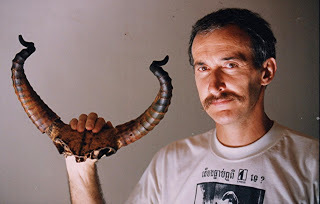 Dr Maurizio Dioli holding a Pseudonovibos spiralis frontlet (© Dr Maurizio Dioli)
Dr Maurizio Dioli holding a Pseudonovibos spiralis frontlet (© Dr Maurizio Dioli)During the 1990s, a startling array of new and rediscovered species of ungulate were revealed in Indochina. Whereas the most famous of these is the saola or Vu Quang ox Pseudoryx nghetinhensis (the remarkable antelope-horned, long-limbed bovine beast that had remained entirely unknown to science until its discovery in Vu Quang, Vietnam, during 1992), the most infamous is the holy goat or kting voar Pseudonovibos spiralis – always assuming, of course, that this hoofed mystery beast ever existed at all...
Its convoluted scientific history began in earnest on a market stall in southern Vietnam's Ho Chi Minh City- for that is where, in early 1994, German zoologist Dr Wolfgang Peter, visiting from Münster's Zoological Gardens, spotted a strange pair of horns that were unlike any that he had seen before. They were approximately 18 in long, heavily spiralled, blackish in colour, and their upper portions were greatly splayed - so that they bore more than a passing resemblance to a somewhat strange pair of motorbike handlebars!
Although he didn't purchase them, Peter did take some photographs. And when he and his colleagues back home in Germanyand elsewhere around the world were unable to assign these mystifying horns to any known species, he and fellow German zoologist Dr Alfred Feiler, from Dresden's State Museum of Natural History, paid several further visits to southern Vietnam. Here they succeeded in uncovering eight pairs of these peculiar horns, one pair becoming the type specimen for the formal description (published by Peter and Feiler later in 1994) of their still-unseen owner as a new species, housed within its own, brand-new genus. Incredibly, this was the third new genus of large ungulate to be described in just over a year, following on from Pseudoryxin 1993 and Megamuntiacus in 1994 (although Megamuntiacus has since been abandoned – its sole species, the giant muntjac M. vuquangensis, having been reassigned to the typical muntjac genus Muntiacus).
Conversations with locals in the Vietnamese districts of Kon Tum, Dac Lac, and Ban Me Thuot revealed that they were familiar with this creature, which they call the linh duong - sometimes translated as 'holy goat'. Another local name given to it translates as 'spiral-horn'. Scientifically, moreover, it is Pseudonovibos spiralis('spiral-horned false kouprey') - emphasising its spiralled horns, and their deceptive similarity in shape to those of the Cambodian wild ox or kouprey Bos(Novibos) sauveli, which itself remained concealed from scientific detection until 1936 and is also deemed controversial nowadays (but that, as they say, is another story!).
 Stunning life-sized statue of a kouprey in Phnom Penh, Cambodia, showing clearly its very distinctive horns (© Prof. Colin Groves)
Stunning life-sized statue of a kouprey in Phnom Penh, Cambodia, showing clearly its very distinctive horns (© Prof. Colin Groves)This, however, is only half of the Pseudonovibossaga. At much the same time that Peter and Feiler were discovering its horns in Vietnam, Norway-based zoologist Dr Maurizio Dioli was visiting northeastern Cambodia's Mondulkiri and Rattanakiri provinces when he purchased two pairs of unusual spiral horns at a market. Each pair was attached to a portion of skull, and seemed to resemble the horns of a juvenile female kouprey.
Upon closer observation, however, Dioli found that the skulls' sutures were completely fused - conclusive proof that the animals had been adults, not juveniles. Moreover, whereas those of female koupreys are smooth and markedly oval in cross section, Dioli's horns bore very pronounced rings, were almost perfectly circular in cross section, and were more widely splayed. Clearly, then, these were not from a kouprey. Nor did they match those from either of the other two species of wild cattle known in Cambodia- the gaur Bos gaurus and the banteng B. javanicus. Indeed, they did not correspond with the horns of any animal documented by science.
When Dioli made enquiries, he learnt from local Cambodian hunters that these mystifying horns belonged to a large bovine beast that they call the kting (or kthing) voar. This name translates as 'wild cow with vine-like horns', referring to their rings and curved shape.
 Holding a kting voar frontlet (© Dr Maurizio Dioli)
Holding a kting voar frontlet (© Dr Maurizio Dioli)Judging from hunters' accounts collected by Dioli and also, more recently, by the Cambodia National Tiger Survey, the kting voar weighs 440-660 lb, stands 3.5-4 ft at the withers, and is said to be somewhat bovine in basic form. However, it is taller and more slender than a banteng or a domestic cow, and has legs like those of the sambar deer Rusa unicolor, as well as a well-developed coat, which is variously claimed to be uniformly greyish-black or dark red in colour. Very shy, rare, fleet-footed, and agile, given to standing on its hind legs to browse off leaves on trees, it lives in small family groups amid the region's mountainous dipterocarp forests. Evidently, therefore, although it has successfully eluded scientific detection, this reclusive animal is no stranger to the region's people, thus making all the more interesting their second, alternative name for it - kting sipuoh, or 'snake-eating wild cow'!
It is not unique for primitive native folklore to incorporate fanciful beliefs regarding herbivorous ungulates consuming serpents - Indian tribes tell similar stories concerning Asia's ibex-like markhor Capra falconeri. Although intriguing, these curious claims have no scientific corroboration.
 An adult male markhor showing its magnificent spiralled horns (© Geographer/Wikipedia –
CC BY 2.5 licence
)
An adult male markhor showing its magnificent spiralled horns (© Geographer/Wikipedia –
CC BY 2.5 licence
)The hunters alleged that when the kting voar devours snakes, these reptiles bite its horns, creating their rings, and imbuing them with venom. This supposedly bestows the horns with medicinal properties against snake bite. Consequently, as soon as a kting voar is killed by a hunter, its horns are removed and used for making venom antidote. This is prepared by burning the horns in a fire - hence few survive to be sold at the markets as trophies.
Not long afterwards, Dioli learnt of Peter and Feiler's investigations, and he recognised that the horns of their Vietnamese holy goat matched those of his Cambodian kting voar. These two mysterious mammals were one and the same - both belonged to the newly-named species Pseudonovibos spiralis. Moreover, Dioli revealed that two horns supposedly from a young female kouprey that were collected in southern Vietnamas long ago as 1929 and donated to the Kansas Museum of Natural History are actually those of Pseudonovibos.
Researches have suggested that Pseudonoviboshad once been most common in Vietnam, but has been so heavily hunted there that today it survives predominantly across the border in Cambodia. Despite being known to the western world now for over 20 years, however, one major mystery remains unsolved. Scientists have yet to spy a living Pseudonovibos- apart from native testimony, therefore, we still do not know for sure what it looks like!
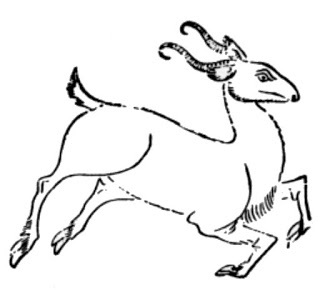 The ling, as portrayed in San Cai Tu Hui (1607) (public domain)
The ling, as portrayed in San Cai Tu Hui (1607) (public domain)Having said that, however, a certain antiquated Chinese encyclopedia may offer a unique clue, as revealed by Drs Alastair A. Macdonald and Lixin N. Yang. Entitled San Cai Tu Hui, compiled by Wang Chi and Wang Si Yi, and published in 1607, it contains a drawing and short piece of accompanying text concerning a sturdy horned creature known as the ling. According to this encyclopedia, the ling: "...looks like a goat but is larger. Its horns are round and have pointed tips". There is also a fanciful account of how it uses its horns to hang from trees at night to sleep. The animal depicted in the drawing does not call to mind any known species of ungulate - except, that is, for its horns, whose shape and ribbed pattern, as acknowledged by Macdonald and Yang, do recall those of Pseudonovibos.
Moreover, in 1999 ateam of German zoologists, which included Feiler and also Dr Ralph Tiedemann from Kiel University, published a short communication documenting the results of some mitochondrial DNA sequence analyses featuring DNA extracted from Pseudonovibos horn fragments and compared with corresponding DNA sequences from a range of other bovid ungulates in an attempt to ascertain its taxonomic affinities. These analyses revealed that Pseudonovibos did seem to be more closely related to goats than to antelopes or to cattle (despite its generic name), but in an e-mail Dr Tiedemann informed me that his team would be publishing more extensive genetic comparisons at a later date.
And in an e-mail to me of 15 December 1999, highly-renowned ungulate and primate expert Prof. Colin Groves, then based at Canberra's Australia National University, revealed that Australian zoologist Dr Jack Giles of Taronga Zoo in Sydneyhad recently visited Vietnam, where he had been shown an old black-and-white photo of a local hunter sitting upon a dead Pseudonovibos! Frustratingly, however, the photo was of such poor quality that little detail could be discerned, other than the fact that the animal was not particularly large. Making matters even worse, the hunter was perched upon the dead beast's head, thereby obscuring any distinguishing facial or cranial features that may have been visible. (After learning this, I promptly wrote to Dr Giles requesting information and sight of this photograph, but unfortunately I did not receive any reply from him.)
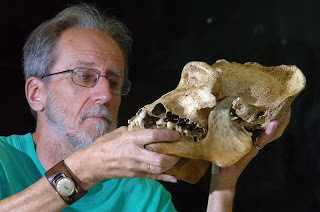 Prof. Colin Groves, examining a deformed male mountain gorilla skull from Rwanda (public domain)
Prof. Colin Groves, examining a deformed male mountain gorilla skull from Rwanda (public domain)Even more tantalising are reports from early January 1995 documenting the capture of a still-unidentified mystery mammal in central Vietnamduring December 1994. An immature female specimen, it was caught alive near the village of A Luoi in the central Vietnamese province of Thua Thien-Hue, more than 180 milessoutheast of Vu Quang (the geographical epicentre for Vietnam's 1990s ungulate discoveries). Referred to by its captors as a tuoa, it died shortly afterwards, and was eaten before its body could be scientifically examined. Its mother had also been captured, but escaped. The calf weighed 36 lb, and was said not to be a saola. Instead, it resembled a goat, with a roundish head, long ears, horns, stout body, and a black and white coat patterned with buff and grey patches. According to quotes attributed to Hanoi Universityzoologist Prof. Ha Dinh Duc, it seemed to be different from any bovid species known scientifically in Vietnam.
Nothing more has been heard about the tuoa, but in view of its morphological description, could this cryptic creature be one and the same as Pseudonovibos? If so, how ironic, and tragic, that the only complete - and living - specimen to come within reach of modern-day science found its way into a local cooking pot instead!
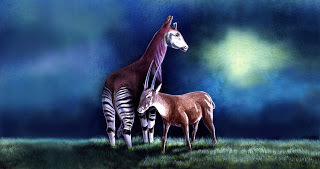 Spectacular painting of an adult saola (right) and okapi (left) prepared specifically by acclaimed American wildlife artist and longstanding friend Bill Rebsamen for my second and third books on new and rediscovered animals (© William M. Rebsamen)
Spectacular painting of an adult saola (right) and okapi (left) prepared specifically by acclaimed American wildlife artist and longstanding friend Bill Rebsamen for my second and third books on new and rediscovered animals (© William M. Rebsamen)Moreover, in his above-noted e-mail to me, Robert Timmins opined that it may already be too late for this most elusive Indochinese hoofed debutante: "It's looking like Pseudonovibos has disappeared like the rhinos for a perceived medicinal value to its horns".
However, we should not - indeed, cannot - forget that during the 1990s Indochinahosted an unparalleled spectacle of mammalogical revelations, and with research continuing here the present 21st century may well witness many more surprises in this cryptozoologically rich and still far from well-explored region. There must surely be hope, therefore, that one of these surprises will be the long-awaited discovery of living specimens of Pseudonovibos – or will it...?
 A selection of individual Pseudonoviboshorns (© Dr Maurizio Dioli)
A selection of individual Pseudonoviboshorns (© Dr Maurizio Dioli)In January 2001, ateam of French biologists including Drs Arnoult Seveau, Herbert Thomas, and Alexandre Hassanin published a pair of startling, highly controversial papers, in which they claimed that Pseudonovibos is non-existent - a forgery. They based their claim upon the results of two separate studies of Pseudonovibosmaterial. In one of these, they sequenced two DNA markers from the bony cores of four sets of Pseudonovibos horns, and compared them with the equivalent genetic markers in Vietnamese domestic cattle. In the second study, they conducted a histological examination of the keratin in six Pseudonovibosfrontlets (the horn-bearing frontal bones of the skull that constitute the animal's brow or forehead). The results of the DNA study revealed that the markers from the Pseudonovibos material were a perfect match with those from the Vietnamese domestic cattle. And the keratin study exposed the Pseudonovibos frontlets' horns to be nothing more than domestic cattle horns whose keratin sheaths had been skilfully manipulated by heat treatment, followed by twisting and trimming, to create the distinctive spiral, heavily-ridged horns characterising Pseudonovibos.
Yet although there can be little (if any?) doubt that these particular specimens are indeed fakes, there is currently no evidence that any of the several other sets of Pseudonovibos horns on record (including this species' type material) are also fraudulent. Hence the French team's bold statement that Pseudonovibos is not a new animal and its scientific name should be abandoned is premature, to say the least. Kansas Universitymammalogist Prof. Robert M. Timm has published an extensive paper on Pseudonovibos, in which he and fellow mammalogist Dr John H. Brandt documented two sets of Pseudonovibostrophy horns procured by two western big game hunters in Vietnamduring 1929 (but not recognised back then to be from anything special or new). Following the appearance of the French team's claims, Timm averred that he had no doubt that Pseudonovibos is a valid taxon, having uncovered various overlooked records from the 1880s and 1950s that documented a mysterious spiral-horned bovine beast ostensibly synonymous with P. spiralis.
Moreover, in a separate paper a team of Eastern European scientists announced that their phylogenetic analyses of nearly-complete 12S mitochondrial rDNA sequences for this enigmatic creature and a number of other bovids indicate that P. spiralis is a valid species belonging to the buffalo subtribe (Bovina), and should be placed between the Asiatic buffaloes Bubalus and the African buffalo Syncerus.
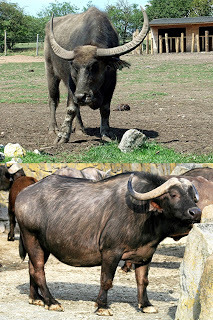 Asian water buffalo Bubalus(top) and African buffalo Syncerus (bottom) (© Dr Karl Shuker / public domain)
Asian water buffalo Bubalus(top) and African buffalo Syncerus (bottom) (© Dr Karl Shuker / public domain)Personally, I consider it possible that the answer to the riddle of whether Pseudonovibos truly exists is that this enigmatic beast is a real but extremely rare species, so rare that procurement of its much-prized, supposedly snake-repelling horns even by locals is extremely difficult - which has in turn led to the deliberate preparation of copies for use in rituals. In other words, some of the preserved horns on record are indeed fakes, yet were created not to fool, but merely to act as substitutes for the real thing. This is also an opinion that has been aired by Prof. Colin Groves, though as he has noted to me, if the type material for Pseudonovibosis examined and is also shown to be fake, then regardless of whether this animal does exist, the name 'Pseudonovibos spiralis' must be abandoned, and every remaining specimen must be examined to see whether any genuine material does exist.
Meanwhile, however, the holy goat remains suspended in a decidedly unholy scientific limbo, and seems destined to remain there indefinitely, or at least until – if ever – further evidence for or against its reality is obtained.
The above ShukerNature blog article is excerpted and expanded from my book The Encyclopaedia of New and Rediscovered Animals . My sincere thanks as ever to Dr Maurizio Dioli for very kindly permitting me to include some of his photographs in my writings.
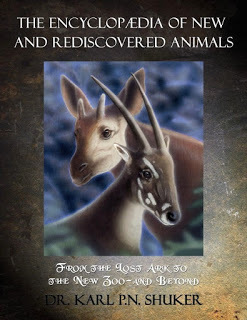
EPILOGUE
In early August 2016, cryptozoological colleague Lorenzo Rossi brought to my attention a very strange but intriguing photograph that he had recently discovered in the entry for Pseudonovibosin Spain's version of Wikipedia (but not present at that time in other countries' Wikipedia entries for Pseudonovibos, although, very oddly, it does currently appear in the English-language Wikimedia Commons entry for the saola!). According to the photo's subject and accompanying caption, it depicted in close-up a living specimen of the kting voar encountered in Cambodia. Remarkably, however, this potentially highly-significant image had (and still has) attracted virtually no cryptozoological attention – ostensibly a very surprising situation, bearing in mind the still-unresolved controversy regarding this notoriously elusive/non-existent creature.
Moreover, in the photo, the creature has either somehow lost its right-hand horn or it is twisted backwards out of sight; and, very bizarrely, a snake appears to be fastened by its jaws to and hanging down from the creature's still-present or visible left-hand horn. Here is the photo in question:
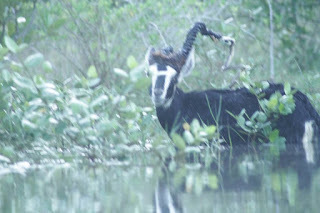 Photograph of an alleged living kting voar in Cambodia, currently still online in Spain's Wikipedia (click
here
to visit the entry) (© Stephenpkirrane/Wikipedia – CC BY-SA 4.0 licence – reproduced here on a strictly non-commercial Fair Use basis only for academic/educational review purposes)
Photograph of an alleged living kting voar in Cambodia, currently still online in Spain's Wikipedia (click
here
to visit the entry) (© Stephenpkirrane/Wikipedia – CC BY-SA 4.0 licence – reproduced here on a strictly non-commercial Fair Use basis only for academic/educational review purposes)Naturally, I was exceedingly curious as to what precisely was depicted in this odd photo (and in a near-identical one that I shortly afterwards discovered on the Cryptidz Wikia site – in the latter, there was more foliage partly obscuring the creature's face), especially as to me it seemed very similar in appearance to ordinary domestic goats commonly seen in Cambodia (such as several of the somewhat frisky individuals currently viewable here in a short YouTube video). Accordingly, I decided to obtain the opinion of a certain internationally-renowned authority on ungulates, who also happened to have an abiding interest in cryptozoology, and with whom I had corresponded on many different subjects (including Pseudonovibos) for many years. I refer of course to the earlier-mentioned mammalogist Prof. Colin Groves, who had delineated and formally described several major new species of mammal in modern times, and whose subsequent passing on 30 November 2017 was a massive loss to mainstream zoology and cryptozoology alike.
I was very interested to discover in his emailed response of 11 August 2016 to my enquiry sent to him a day earlier (and also in a subsequent, more detailed phone conversation between us regarding this matter) that Prof. Groves aired precisely the same thoughts that had occurred to me when perusing the image. Here are his most significant comments from his email:
I certainly agree with you about the goat… [and] if you [look] carefully there is a very distinct join along the forehead. I would think it just must be that rare thing, a goat standing in water (or else the water has been photoshopped into the picture)… The other one [horn] is just visible at the base, evidently skewed backward. It may be that the only frontlet and horns available to the photographer or photoshopper was defective in some way, maybe the right horn had broken off and what remained of it was pulled out of sight… The rather scruffy hair along the bases of the horns is brownish.
Summarising his emailed and phone comments: Prof. Groves personally deemed the photo to be of a domestic Cambodian goat either directly photographed or digitally photoshopped standing in water, with a Pseudonovibos frontlet bearing brown hair at its base either physically attached to or digitally photoshopped onto its black-haired head, and with one of the frontlet's horns broken off or twisted virtually out of sight. A nice touch also commented upon by Prof. Groves was the snake hanging down from the fully-visible left horn, because this immediately recalls the horn-biting snake-related folklore linked to the kting voar.
All in all, a photograph every bit as enigmatic as the highly ambiguous animal that it purportedly portrays – a fitting conclusion, in fact, to a lengthy, tortuous tale as twisted and contorted as the spiralled horns of Pseudonovibos itself!
I wish to dedicate this ShukerNature blog article to the memory of Prof. Colin Groves, in grateful thanks to him for his kind and always much-valued assistance and responses to my many enquiries on all manner of mutually interesting wildlife subjects down through the years.
 Prof. Colin Groves (1942-2017), RIP. (public domain)
Prof. Colin Groves (1942-2017), RIP. (public domain)
Published on February 22, 2019 07:43
January 25, 2019
CELEBRATING TEN YEARS OF SHUKERNATURE, VIA ITS ALL-TIME TOP TEN ARTICLES
 My ShukerNature blog's official banner, very kindly designed for me by Mark North (© Dr Karl Shuker)
My ShukerNature blog's official banner, very kindly designed for me by Mark North (© Dr Karl Shuker)Yes indeed – this week is a very momentous occasion in the history of my ShukerNature blog, because it was exactly 10 years ago this week, on 20 January 2009 to be precise, that I uploaded onto it my very first (albeit very short) article (click here to access it), and the rest, as they do say, is history.
So what better way to celebrate ShukerNature's tenth anniversary than to present (in what is its 652nd article) a clickable listing of its all-time top ten articles, as determined by their respective total number of visitor hits received. And here they are, with their total hit counts as of right now included in brackets following their links:
#1 Black Lions – Manipulation, Melanism, and Mozaicism(1,303,981)
#2 Mermaid Body Found? In Search of Folk With Fins(238,085)
#3 The Truth About Black Pumas – Separating Fact From Fiction Regarding Melanistic Cougars(194,338)
#4 Half-Human Half-Rabbit Hybrid – The Tragic Truth?(141,930)
#5 Mystery of the Venezuelan Poodle Moth – Have You Seen This Insect?(130,486)
#6 The Truth About Brazil's Amazing 'Penis Snake' – Not a Snake, and Certainly Not a… (98,634)
#7 Giant Sea Serpents and Chupacabra Snails – Welcome to the Monstrous Menagerie of Takeshi Yamada(98,474)
#8 Portraits of a Potoo – Neither an Alien Avian Nor the Bird From Hell!(83,210)
#9 Exposing Another Black Lion Photograph as a Fake(65,868)
#10 The Giant Grasshopper of Wisconsin – Focusing Upon a Phoney Photograph (53,427)
Judging from the subjects covered by the above articles, melanistic mystery cats seem to be of considerable interest to ShukerNature readers, as no fewer than three of the top ten articles (out of a total of no fewer than 652) are devoted to the investigation of such creatures and, in particular, alleged photos of such. Intriguing images also form the basis of a further four, purportedly portraying such diverse entities as an unexpectedly fluffy moth, a bizarre bird with a gargantuan gape, a monstrously huge grasshopper, and a grotesque being likened to an incongruous human-rabbit hybrid but likely to have been something much less extraordinary yet far more tragic.
Stir into this singular mix some truly bizarre beasts conjured forth into tangible existence by the creative genius of a celebrated master in manipulation and design, plus the perennially-popular saga of merfolk, and never forgetting a remarkable amphibian whose memorable external appearance has earned for it from the ever-imaginative media an even more memorable monicker, and the result is a listing of fascinating subjects that could not be found together anywhere else online, only here on ShukerNature, along with 642 other no less enthralling and entertaining topics too.
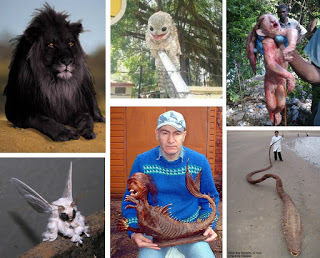 Subjects covered in some of my top ten ShukerNature blog articles (mermaid photo (© Dr Karl Shuker; Venezuelan poodle moth © Arthur Anker; giant sea serpent gaff photo © Takeshi Yamada; © of the other photos unknown to me but presented here on a strictly non-commercial Fair Use basis only)
Subjects covered in some of my top ten ShukerNature blog articles (mermaid photo (© Dr Karl Shuker; Venezuelan poodle moth © Arthur Anker; giant sea serpent gaff photo © Takeshi Yamada; © of the other photos unknown to me but presented here on a strictly non-commercial Fair Use basis only)So here's hoping that they will continue to be of interest to readers for a long time to come, and that I will be able to continue adding further ones to their elite company.
Finally, I'm happy to say that my long-awaited, long-promised ShukerNature book will be published during this coming spring, containing an exceedingly varied selection of my blog's articles in expanded, updated form, fully illustrated throughout in colour, and supplemented by a very extensive bibliography of sources consulted by me during their preparation. Look out here on ShukerNature for further updates as I receive them.
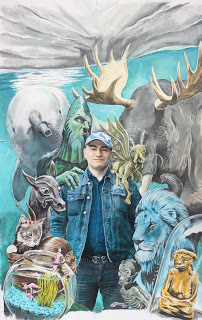 The original and extremely beautiful artwork specially prepared for the front cover of my forthcoming ShukerNature book by renowned artist Anthony Wallis (© Dr Karl Shuker/Anthony Wallis)
The original and extremely beautiful artwork specially prepared for the front cover of my forthcoming ShukerNature book by renowned artist Anthony Wallis (© Dr Karl Shuker/Anthony Wallis)
Published on January 25, 2019 08:09
December 31, 2018
TRAILING THE HOUNDS OF HELL - BLACK DOGS, WISH HOUNDS, AND OTHER CANINE PHANTASMS
There stood a foul thing, a great, black beast, shaped like a hound, yet larger than any hound that ever mortal eye has rested upon. And even as they looked the thing tore the throat out of Hugo Baskerville, on which, as it turned its blazing eyes and dripping jaws upon them, the three [men] shrieked with fear and rode for dear life, still screaming, across the moor.
Sir Arthur Conan Doyle – The Hound of the Baskervilles
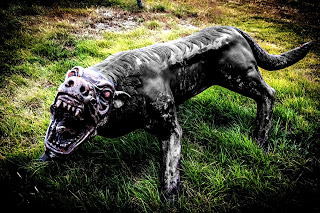 Monstrous black dog statue in New Zealand (public domain)
Monstrous black dog statue in New Zealand (public domain)In many lands around the world, the week spanning Christmas Day and New Year's Day is often deemed to be an uncanny even preternatural period of time, during which all manner of strange events may occur or surreal entities be seen. So when better than now to present as my final ShukerNature article for 2018, an examination of the truly mystifying phenomenon of phantom Black Dogs.
The monstrous canine star of Sir Arthur Conan Doyle's most famous Sherlock Holmes novel would be terrifying enough if it were wholly fictitious. Incredibly, however, Conan Doyle's inspiration came from reality – generations of sightings and lore concerning a black-furred phantom dog known locally as the Black Dog of Hergest on the English-Welsh border. Moreover, many people do not realise that there really is a Baskerville Hall, near the Welsh border village of Clyro, to be precise – at which Conan Doyle stayed, and where he heard tales of the ominous Black Dog.
It was only to preserve the privacy of the Baskerville family that when Conan Doyle decided to use their name and the Black Dog legend as the basis for a forthcoming Sherlock Holmes novel, he relocated it from Wales to Dartmoor. Yet here too there are a number of legends of spectral, ebony-hued hounds with fiery eyes (of which Conan Doyle was also aware), just as there are in many other British localities, as well as in mainland Europe, and even in regions as far-flung as North America and Australia. Collectively, these canine apparitions are variously referred to as Black Dogs or Hell Hounds, and are among the most perplexing, and, quite often, sinister, zooform (animal-assuming, paranormal) entities on record.
 The Hound of the Baskervilles, by Sidney Paget (public domain)
The Hound of the Baskervilles, by Sidney Paget (public domain)Many sightings are associated with certain country lanes or paths, and there is more than one inn and public house in England named 'The Black Dog' on account of Black Dog legends linked to nearby walkways. Churchyards are another frequently-reported location for Black Dog sightings (these Black Dogs are termed Church Grims or Kirkgrims), as are localities close to stretches of water, and even certain urban roads and streets are reputedly haunted by these eerie entities.
So commonly spied are certain regional Black Dog manifestations that they have their own names, such as Black Shuck in Norfolk, Padfoot in Staffordshire, Barguest in Yorkshire, Hooter in Warwickshire, Hairy Jack in Lincolnshire, Gwyllgi (Welsh for 'dog of darkness') on the Welsh coast, Mauthe Doog in the Isle of Man, Skriker ('howler') or Trask in Lancashire, Muckle Black Tyke in parts of Scotland, and Tchico in Jersey.
 'Church Grim', painted by Inès Lee and commissioned by Sir John Das (© Wikipedia/ Inès Lee – CC BY-SA 4.0 licence)
'Church Grim', painted by Inès Lee and commissioned by Sir John Das (© Wikipedia/ Inès Lee – CC BY-SA 4.0 licence)WHAT MAKES A BLACK DOG A 'BLACK DOG'?
Of course, there are all manner of comfortingly corporeal, perfectly prosaic canine beasties running loose in our towns and countryside, having absconded from or been let off the lead by their owners. So how can we tell these 'normal' black dogs from the 'real' Black Dogs? There are, in fact, several very important signs to look out for.
NOW YOU SEE IT, NOW YOU DON'T!
First and foremost: Black Dogs often exhibit the alarming ability to vanish into thin air, in full view of their astonished eyewitnesses. One excellent example of this occurred on 19 April 1972 at Gorleston, in Norfolk. It was about 4.45 am, when coastguard Graham Grant caught sight of a very big, jet-black hound-like creature running along the beach. Grant stood watching it for a few moments until suddenly, as he continued to look at it, the animal disappeared! One second it was there, the next – gone!
Across 'the pond', 16-year-old Mark Chester from Atlanta, Georgia, and a friend, Jeff, were driving one evening in 1979 along the aptly-named North Druid Hills Road when, about 75 yards ahead on his side, Mark saw what looked like a black labrador retriever trot out into the road. As it was not yet dark and the road was well lit by streetlights, this animal was perfectly visible, despite its dark coat. To the teenager's amazement, however, just as the 'dog' was approximately three-quarters of the way across the road, it simply vanished. Jeff saw it vanish too. Recalling the incident 15 years later, Mark was still certain of what he had seen: "I know what I saw. There is no doubt in my mind that something was in the road that night and then it wasn't".
In 1981, Irene Cole and her husband were driving along the Stanner Road in Herefordshire, and were just a mile or so from Kington, when they saw an immense Black Dog sitting motionless in the road, at the bottom of a hill. Her husband swerved to miss it, there was no impact, and the dog simply vanished, without a trace.
 The main road that the Wednesbury-Darlaston Brown Dog has often been seen crossing, only for it to vanish before reaching the other side (© Dr Karl Shuker)
The main road that the Wednesbury-Darlaston Brown Dog has often been seen crossing, only for it to vanish before reaching the other side (© Dr Karl Shuker)Intriguingly, there is a main road situated little more than a mile from where I live in the West Midlands, linking the urban towns of Wednesbury and Darlaston, that has a longstanding history of evanescent Black Dog occurrences – though the term 'Black Dog' is applied somewhat loosely here...bearing in mind that this particular Black Dog is actually brown! Be that as it may, in best Black Dog tradition this Brown Dog is allegedly seen crossing the road, only to vanish from sight before reaching the other side. So far, I have never seen it myself, but as it is supposed to be an ill omen, this is probably no bad thing! (Having said that, my surname is actually linked to Black Dogs – click
OMENS OF DOOM – TOUCH NOT THE DOG!
Certainly, a notable characteristic of Black Dogs according to legend, lore, and also modern-day testimony is that they are said to be harbingers of doom, their appearance often foretelling death or impending bad luck – and which is almost always guaranteed if anyone is unwise enough to touch such a creature, especially if done in a violent, threatening manner.
One evening in 1927, a friend of the famous Manx author Walter Gill was walking along a road close to Ramsey when he came upon a typical phantasmal Black Dog – jet-furred and fiery-eyed – standing directly in his path so that he was unable to pass, and staring resolutely into his face. Mindful of the danger of making physical contact with a Black Dog, Gill's friend made no attempt to push by it, but stood his ground and waited, until eventually the Black Dog moved to one side, allowing him to pass. Nevertheless, its very presence had seemingly been dire enough, for not long afterwards the father of Gill's friend died, and he was convinced that the Black Dog's appearance had been a warning of this.
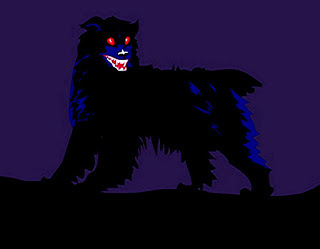 Fiery glowing eyes are a recurring characteristic of Black Dog reports (public domain)
Fiery glowing eyes are a recurring characteristic of Black Dog reports (public domain)Back in 1893, two men driving a cart along a Norfolk lane had similarly encountered a blaze-eyed Black Dog blocking their path. Unlike Gill's friend, however, they had shown far less patience and wisdom, because the driver aggressively ran their cart directly at the creature! As soon as the cart hit it, however, the Black Dog vanished in a brilliant ball of fire, filling the air with a vile sulphurous stench, and just a few days later the driver died.
Judging from that, the Dartmoor farmer who struck with a poker a red-eyed Black Dog that had appeared outside his and his wife's bedroom door one early winter morning in 1972 was lucky indeed to escape with his life. Just as in the Norfolk incident, the Black Dog instantly vanished in a blinding, exploding flash of light, but the farmer and his wife experienced no ill effects. The same, however, could not be said for their house, whose entire electrical circuitry was destroyed, along with every window, and even a number of tiles on the roof were dislodged, such was the power of the explosion.
Sometimes, those few who have been brave, or foolish, enough to touch a Black Dog and have survived the experience have reported a very eerie characteristic of their close encounters. Stretching out to stroke or pat the Black Dog, they have found to their amazement that their hand has passed straight through it, as if the creature were no more than an illusion, or ghost, and also that the Black Dog has not even reacted to their action – just as if it were not even aware of their presence.
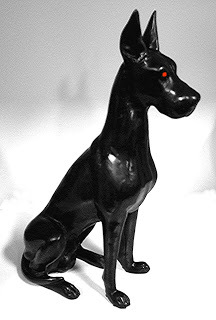 Statuette of a Black Dog (© Dr Karl Shuker)
Statuette of a Black Dog (© Dr Karl Shuker)EYES OF FIRE
As already noticeable from the reports documented so far, a readily visible feature immediately distinguishing Black Dogs from black dogs is the blazing, scarlet appearance of the former entities' eyes. "Like live coals inside the monstrous head" is how one terrified Black Dog eyewitness, a student from Trinity College, Dublin, described them after seeing a huge Black Dog walking towards him one spring day in 1928, as he was fishing in a river close to his Londonderry home during the Easter holiday. So petrified was the student by this rapidly-approaching apparition that he abandoned his fishing and clambered for safety into the branches of a tree close by, from where, still shaking with fright, he gazed down as the Black Dog walked underneath and looked up at him, baring its teeth, before passing on by.
Eye-shine in normal, flesh-and-blood dogs is a greenish-yellow glow. Having said that, during some investigations of mine into eye-shine in animals I discovered that certain eye conditions, such as cataracts and keratitis, can create an abnormal reddish eye glow or bloom in dogs (click here for more information). So it is possible that at least a few cases of red-eyed Black Dogs were actually nothing more than normal, flesh-and-blood black dogs with eye ailments. However, this cannot explain all Black Dog reports with glowing red eyes – there are far too many on record.
Rough, shaggy fur is another frequently-described facet of Black Dog morphology, as well as caliginous, and sometimes fiery, sulphurous breath - more distinct than the normal panting breath of a dog rendered visible on a cold morning.
 A rough-furred, labrador-lookalike Black Dog pub sign (© Dr Karl Shuker)
A rough-furred, labrador-lookalike Black Dog pub sign (© Dr Karl Shuker)THE SILENCE OF THE DOGS
In the vast majority of reported cases, Black Dogs are said to be entirely silent, padding alongside or near to their eyewitness in a spookily soundless manner. Curiously, however, one or two of these ghostly creatures are associated with the sound of rattling chains, and there are also a handful of reports describing splashing noises, as if the creature were wading through or emerging from water.
A famous Black Dog associated with chains is the Newgate Monster, reported and depicted in a broadside from as long ago as 1638. This sinister Black Dog apparently was often seen gliding up and down the streets adjacent to the ivy-covered wall at the end of Amen Court, and sometimes crawling along the top of the wall itself, dragging a heavy chain, just before an execution was due to take place at the original Newgate Prison nearby (the new Newgate Prison was built there in 1783).
Moreover, in traditional lore, some of the diabolical Hell Hounds are given to voicing ferocious, spine-chilling howls and bays, terrifying their onlookers.
 Two engraving depicting the Newgate Black Dog and its chain (public domain)
Two engraving depicting the Newgate Black Dog and its chain (public domain)
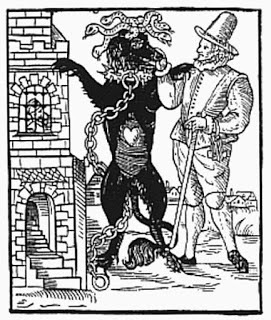
LARGER THAN LIFE
An extremely noticeable physical characteristic of Black Dogs is their very large size. For whereas some have been likened to labradors, others have been compared in size with calves and even small horses! Take, for instance, the red-eyed Irish Black Dog seen lying in the road early one evening in the 1930s by a person walking her dog close to County Mayo's Pontoon Bridge Hotel – so huge did it appear that she had initially assumed it to be a donkey! Similarly, the fiery-eyed, shaggy-furred Black Dog that haunts a lane in Uplyme, Devon – so regularly, in fact, that this route is actually named Dog Lane (there is also a Black Dog hotel there) – was said by a local woman who saw it in 1856 to be as big as a calf.
Intriguingly, in October 1972 Tavistock police constable John Duckworth spied an enormous canine mystery beast on Dartmoor – resembling a black hound the size of a small pony, it had been seen by him once before, three years earlier. As recently as 1995, James Sanderson and three friends were driving home from Smarden, Kent, when they stopped in some fog, and were astonished to see a Black Dog walk by that was as big as their car. In 1986, after hearing a scratching sound in his yard, Robert Harman of South Tuckswood, Suffolk, decided to investigate, and was very startled to see a huge dog with red eyes leap over his wall.
In 2001, Danish theologian Lars Munk encountered the famous Black Dog of Viborg, Denmark, one evening just after midnight at the ley-linked location within Viborg where this canine entity has been sighted many times down through the centuries. Sporting pointed ears and a ridge of harsh hairs along its back, it walked under a street light and looked directly at Munk, shimmering with a weird flickering fluorescent-green light before abruptly disappearing into the darkness. Clearly, Black Dogs are still very much around!
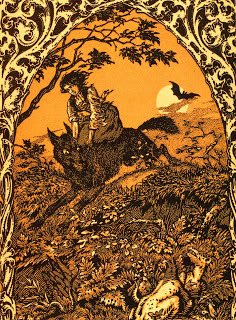 A Black Dog ridden by a witch, from La Vie Execrable de Guillemette Babin, Sorciere, 1926 (public domain)
A Black Dog ridden by a witch, from La Vie Execrable de Guillemette Babin, Sorciere, 1926 (public domain)WHAT ARE BLACK DOGS?
There can be little doubt, judging from the sizeable archive of reports on file, that Black Dogs do exist – but what they actually are is much less easy to determine. Their ability to vanish in full view of their observer and their apparent insubstantial nature confirm that unlike their feline counterparts, Britain's motley assortment of mystery cats, Black Dogs are more than merely elusive creatures of cryptozoology. Instead, they are non-physical, preternatural entities, of superficially canine appearance but exhibiting some unequivocally non-canine attributes, both morphological and behavioural.
Based upon their definite attachment to certain specific physical localities, especially certain lanes, streams or rivers, churchyards, and even some ancient sites (many researchers have noted links between Black Dog appearances and the presence of ley lines, which are in turn associated with these types of locality), a popular identity proffered by investigators is that Black Dogs are a form of preserved image from the past – somehow preserved within a locality's geological composition, and which can be activated if precise meteorological conditions are met. Similar notions have also been proposed to explain other spectral phenomena, such as ghosts, and disembodied voices.
It would be as if a film projector loaded with a loop of film had suddenly been switched on, and its film had been allowed to run its course. This theory would certainly help to explain various anomalous Black Dog reports in which the Black Dog has not interacted with its observer in any way, instead behaving in a manner seemingly oblivious to the observer's presence. In contrast, however, most Black Dog cases involve direct interaction between observer and Black Dog, which could not occur if the latter entity were, in essence, nothing more than a preserved, meteorologically-triggered, moving image from the past.
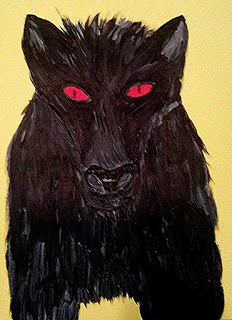 Are Black Dogs hallucinations? (© Jane Cooper)
Are Black Dogs hallucinations? (© Jane Cooper)A related hypothesis is that certain meteorological conditions, especially those associated with electrical phenomena, may induce hallucinations in people susceptible to such stimuli. There is also the analogous possibility that some Black Dog experiences are temporal lobe apparitions – damage or malfunctions in this particular paired region of the brain are known to generate hallucinations during epileptic seizures, including ones that have the appearance (to the subject experiencing them) of external paranormal phenomena, including unearthly entities. Yet another psychologically-grounded theory is that certain people are actively generating these canine apparitions using the power, consciously or otherwise, of their own mind, yielding tulpoid Black Dogs that can fully interact with their creators and even other people.
In some cases, they may even be hallucinations brought about by fatigue. For example, crypto-colleague George Warren Shank mentioned to me in September 2012 that in the USA truckers and other long-distance drivers are so familiar with spying non-existent black dogs induced by sleep deprivation and tiredness that they refer to them as dodgers, and on more than one occasion have nearly swerved off the road in order to avoid hitting such creatures, only to discover that there was nothing there.
Perhaps the most popular idea is that Black Dogs are archetypal guardians of their respective localities, and, by extension in some cases, of people passing through these localities. There are several cases on file, for instance, of women walking alone at night along some lonely, potentially dangerous road, only to find themselves abruptly accompanied by a large Black Dog, walking silently beside them, and staying in their company until they are close or within sight of their destination, whereupon the dog vanishes as mysteriously and suddenly as it had appeared.
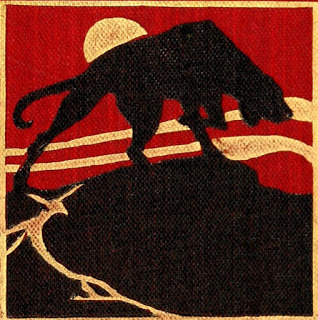 The Black Dog – an aloof anomaly in canine guise (public domain)
The Black Dog – an aloof anomaly in canine guise (public domain)CANINE ENCOUNTERS OF THE BIZARRE KIND!
Whereas most Black Dogs are of the traditional, quasi-labrador kind described above, notwithstanding their fiery eyes and often-intangible nature, some far more exotic, even downright bizarre variations on this canine theme have also been reported.
Black Shuck of Norfolk usually assumes the 'normal' Black Dog form, but on occasion has been reported as a terrifying hound totally lacking a head! Moreover, sometimes his head is missing but his blazing eyes are still present, floating in a decidedly unnerving, disembodied manner above his body at the level at which they would be if his head were present!
And speaking of headless hounds: the spectral Wish Hounds of Dartmoor (also termed Yeth Hounds or Yell Hounds) are also said to lack heads, whereas the unique Black Dog that traditionally haunts the environs of Suffolk's Clopton Hall is human-headed – specifically, it sports the head of a cowled monk.
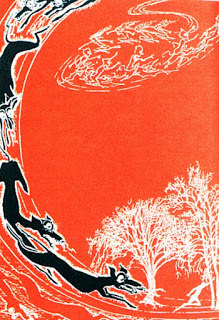 Hell Hounds pursuing a human victim during the Wild Hunt (public domain)
Hell Hounds pursuing a human victim during the Wild Hunt (public domain)Most terrifying of all are the Devil's Dandy Dogs. Hailing from Cornwall, these huge jet-black diabolical Hell Hounds have saucer-sized blazing eyes, tongues of fire dart from their mouth, and on their head is a pair of horns! They are said to accompany the devil when he hunts on horseback across the Cornish moors, in search of human souls.
Incidentally, whenever I read about such creatures having saucer-sized eyes, I am irresistibly reminded of the trio of giant black huge-eyed dogs encountered by the soldier in Hans Christian Andersen's famous fairy tale 'The Tinder Box'. Might this story have been inspired by real-life reports of phantom Black Dogs in his native Denmark?
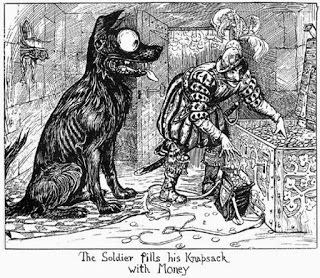 One of the three huge-eyed black dogs encountered by the soldier when opening the magic tinder box in Hans Christian Andersen's beloved fairy tale – illustrated by H.J. Ford for Andrew Lang's Yellow Fairy Book, 1894 (public domain)
One of the three huge-eyed black dogs encountered by the soldier when opening the magic tinder box in Hans Christian Andersen's beloved fairy tale – illustrated by H.J. Ford for Andrew Lang's Yellow Fairy Book, 1894 (public domain)BEWARE THE BEAST OF BUNGAY!
One of the most terrifying Black Dog appearances ever recorded allegedly took place on the morning of 4 August 1577 in the small Suffolk town of Bungay. During a fierce electrical storm, a ferocious, malevolent Black Dog materialised inside St Mary's Church, and ran amok through it, attacking the terrified parishioners and leaving havoc and horror in its wake. According to records dating from that time, this "strange and terrible wunder [sic]" tore the throats out of its victims, and scorched one hapless man as if he were a piece of leather burnt in a hot fire. Nor was that all.
Other records claim that on that same day, during the electrical storm, what was presumably the same Black Dog appeared 10 miles away inside another Suffolk church, this time the splendorous Holy Trinity Church at Blythburgh, where similar devastation ensued, with at least three people being slain by the beast, and even the church steeple collapsing, causing the deaths of several more parishioners inside. Moreover, when this Hell Hound finally exited the church, it left the marks of its great claws gouged into the church's door, which can still be seen today (a modern-day photo of them is contained in Graham McEwan's book Mystery Animals of Britain and Ireland, 1986).
 Pamphlet from 1577 recording the incredible case of the Bungay Black Dog (public domain)
Pamphlet from 1577 recording the incredible case of the Bungay Black Dog (public domain)In reality, all of this may have been nothing more dramatic than a massive lightning strike, or even a fireball, transformed by imaginative chroniclers into a supernatural canine visitation. Then again, as revealed here, Black Dog appearances are far from uncommon or unusual events. And something definitely left behind those claw-like marks on the church door at Blythburgh.
Worth noting is that possibly the earliest Black Dog appearance on record (chronicled in 856 AD by Bertin in the Annales Francorum Regum) featured a red-eyed Black Dog materialising inside a village church during a service, this time in France, where it ran around the altar for a time, seemingly looking for someone, before abruptly vanishing into thin air.
Another early manifestation of a Black Dog allegedly took place one evening in 1552, while Cardinal Crescentius, the papal ambassador to the Council of Trent and infamous for his merciless persecution of supposed wrong-doers, was sitting in his chamber writing a missive to Pope Julius III. Suddenly, a huge flaming-eyed Black Dog with long ears dangling down to the ground materialised before him and moved towards him under the great table at which he was sitting. Both amazed and alarmed, the Cardinal cried out to his servants to enter his chamber and rid him of this foul creature, but to his even greater amazement when they did enter they were unable to see the Black Dog. This shocked him so much that he fell ill, but to his dying day he swore that he could definitely see it, and even claimed that it was climbing onto his bed.
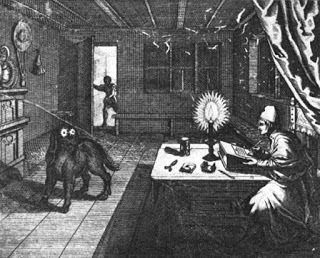 Engraving depicting the glowing-eyed Black Dog that reputedly appeared inside the chamber of Cardinal Crescentius (public domain)
Engraving depicting the glowing-eyed Black Dog that reputedly appeared inside the chamber of Cardinal Crescentius (public domain)In today's ultra-technological world, governed by logic and science at every turn, Black Dogs and other incorporeal canine entities seem sorely out of place, just anachronistic superstitions and shadowy dreams from earlier, magical ages that have no business in the mundane modern-day era. And yet still they persist, legends come to life, doggedly(!) continuing to be reported even today – subtle proof, perhaps, if proof be needed, that the present and the past may well remain intertwined by far more than mere memory.
And finally: from the world of fiction but definitely deserving of inclusion in any coverage of hell hounds and other paranormal pooches, I give you Zoltan - Hound of Dracula!
At length, the creature lifted its head, letting the limp, rag-doll torso of the soldier slump disjointedly back to the ground. Its ears rose up, satanic and pointed. Its eyes blazed with an unnatural, greenish light. Its enormous jaws, flanked on either side by abnormally huge canine fangs, were drenched in blood that dripped in great gobs to the dusty floor, as a great swathe of a tongue lashed obscenely from side to side with relish.
A hound from hell itself had returned...and was now satiated, renewed with warm, youthful blood.
Ken Johnson – Zoltan – Hound of Dracula
 Front cover of Zoltan – Hound of Dracula, by Ken Johnson, originally published in 1977 as Hounds of Dracula, and upon which the 1978 American horror movie Dracula's Dog (vt Zoltan - Hound of Dracula in the UK) was based (© Ken Johnson/Everest Books – reproduced here on a strictly non-commercial Fair Use basis for educational/review purposes only)
Front cover of Zoltan – Hound of Dracula, by Ken Johnson, originally published in 1977 as Hounds of Dracula, and upon which the 1978 American horror movie Dracula's Dog (vt Zoltan - Hound of Dracula in the UK) was based (© Ken Johnson/Everest Books – reproduced here on a strictly non-commercial Fair Use basis for educational/review purposes only)
Published on December 31, 2018 09:02
November 30, 2018
REMEMBERING THE BEAST OF BODALOG - A WELSH WATER VAMPIRE?
Something has crept, or has been driven out of dark waters under the mountains...Far, far below the deepest delvings of the Dwarves, the world is gnawed by nameless things.
J.R.R. Tolkien - The Lord of the Rings
 Could the Bodalog Beast have been a large snake species living in Britain and readily able to swim, such as the common grass snake, as depicted here in a beautiful illustration by Heinrich Harder from 1912? (public domain)
Could the Bodalog Beast have been a large snake species living in Britain and readily able to swim, such as the common grass snake, as depicted here in a beautiful illustration by Heinrich Harder from 1912? (public domain)Thirty years ago, one of the strangest, eeriest cryptozoological cases ever reported from the British Isles was making headlines nationally and even internationally, and three decades later it has still never been satisfactorily resolved. So here is my contribution to its very intriguing history, by way of an article of mine that was subsequently converted into a chapter within my book From Flying Toads To Snakes With Wings (1997) and serves now in updated form as a fitting ShukerNature retrospective to, and reminder of, this macabre yet nowadays all-but-forgotten saga.
To describe one of Britain's most bizarre mystery beasts as a water vampire may not be as melodramatic as one would first suppose - especially after considering its unique characteristics. According to media reports, during September to December 1988 its home was seemingly a lengthy river, the River Wye, situated close to the town of Rhayader in mid-Wales, from which it apparently emerged at night to kill sheep on a nearby 2000-acre farm called Bodalog, owned by the Pugh family. Unlike those of foxes and dogs, however, its victims' carcasses were not ripped or torn in any way. Instead, the only sign of their mystifying marauder's attack was a small but deep, penetrating bite just below the neck, close to the sternum or breast-bone (and which duly earned it the memorable monicker of water vampire in some media accounts). No evidence of the creature feeding upon the carcasses was found either, thus making its predatory behaviour even more weird and difficult to understand.
Nevertheless, by the middle of October 1988 this mysterious beast had killed at least 35 sheep. Its scent had been trailed back and forth to the river by foxhounds, but it was never seen or identified, and no recognisable pawprints were found either. As noted by London's Daily Mail newspaper on 10 October 1988, many suggestions regarding its possible identity had been offered, ranging from otter and dog, to mink and even to some form of snake. University scientists had examined the carcasses and admitted to being thoroughly perplexed.
Their bewilderment is not surprising, as the Bodalog beast clearly poses some singular problems, with none of the more conservative explanations satisfying the facts available.

 Could it have been a native European otter (above) or a naturalised American mink (below) (public domain / © Cephas/Wikipedia CC BY-SA 3.0 licence)
Could it have been a native European otter (above) or a naturalised American mink (below) (public domain / © Cephas/Wikipedia CC BY-SA 3.0 licence)Its aquatic habitat immediately rules out a fox, cat (even an escapee big cat), or stray dog as the culprit - as well as a human hunter using a crossbow, which had also been suggested by some authorities. European otters Lutra lutra are relatively large creatures, but are certainly not sheep killers. They are known to take small mammals in their diet from time to time, but nothing approaching the size of a sheep. In any event, their principal sources of food are fishes and aquatic crustaceans - and, needless to say, they do eat prey killed by them and they do leave tell-tale spoor behind.
Mink, although much smaller than otters, are far more bloodthirsty by nature. Not native to the British Isles, they now exist in a naturalised state in many parts of the country - descendants of fur-farm escapees belonging to the American species, Neovison vison. Mink have wide tastes, ranging from fishes to birds as large as moorhens, and mammals as large as young rabbits (reports even exist of mink having killed pet cats and dogs!). Nevertheless, sheep would surely be far too large for any mink to tackle successfully.
One suggestion, from an unnamed 'expert', was that some form of giant mink was responsible! Mink, however, do not normally attain a total length greater than about 26 inches in the wild, and there is no evidence whatsoever that mink of a size commensurate for sheep killing have ever existed in Britain.
A little-known species called the sea mink N. macrodon once inhabited the coastal waters of New England and the Canadian maritime provinces, and was indeed somewhat larger than other mink species, but it became extinct in the early 1880s, and is totally unknown either in living or in fossil form in the Old World.
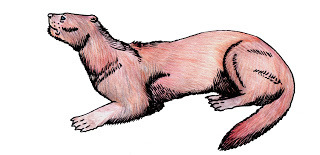 Artistic representation of the sea mink's likely appearance in life (© Tim Morris)
Artistic representation of the sea mink's likely appearance in life (© Tim Morris)Britain only has four native species of snake [as revealed below, herpetologists announced in 2017 that there were actually two taxonomically distinct species of grass snake living here, not just one, thus transforming the UK's traditionally recognised trio of endemic ophidians species into a quartet]. The sole venomous species is the European viper or adder Vipera berus, which is predominantly ground-living, diurnal, and feeds on nothing larger than lizards and small mammals.
Relatively more aquatic by nature are the non-venomous and diurnal common or eastern grass snake Natrix natrix and its close relative the barred grass snake N. helvetica. The preferred prey species of these two species are amphibians and fishes, though nestling birds and small mammals are also occasionally taken.
Britain also has a small number of the smooth snake Coronella austriaca, confined to southern England. This is another non-venomous, diurnal species whose diet consists mainly of lizards and small mammals.
Also worthy of note is the aesculapian snake Zamenis longissimus, which is a mainland European species that has established a couple of small but seemingly thriving naturalised population in Great Britain – one in central London, England, and the other in Colwyn Bay, Wales. Both populations originally arose from escapee/released specimens surviving and mating in the wild in these locations. So might the Beast of Bodalog have been an aesculapian snake, derived from the Welsh contingent? At up to 7 ft long, this species is certainly lengthier than any of Britain's native species, but just like all of them it is diurnal, and it is not venomous. Clearly, therefore, none of these five species constitutes a very convincing candidate for the Welsh sheep killer.
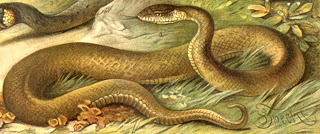 Vintage chromolithograph from 1909 of the aesculapian snake (public domain)
Vintage chromolithograph from 1909 of the aesculapian snake (public domain)It has never been formally ascertained whether the Pughs' sheep were actually poisoned by their attacker, but if tests were to reveal that this did occur, then it is possible that a non-native and evidently sizeable, aquatic venomous snake was on the loose at that time. It could have been a pet that either escaped or, for some reason, was released, as in the above-noted London and Welsh instances featuring the aesculapian snake. Yet if this were true, then it could have potentially posed a very real, severe dilemma - for there are few animals on Earth as elusive as snakes, especially those species that are adept at travelling not only across the land but also through the water.
Perhaps, then, it is not too surprising that the sinister 'water vampire' of Wales was never seen, let alone tracked down. Its killing spree abruptly ended in early December 1988, and nothing like it has ever been reported since from Bodalog (or anywhere else, for that matter, at least as far as I am aware), so presumably it simply died (see below) - always assuming, of course, that it didn't move elsewhere. Yet if it had indeed been some form of very large, powerful snake, why did it kill so many sheep but never make any attempt to feed upon their carcasses afterwards?
Moreover, how could such a creature have survived for at least two months in the distinctly chilly climate present in mid-Wales during late autumn/early winter? After all, snakes are poikilothermic (cold-blooded) and therefore rely upon warm external, environmental temperatures to maintain their own body heat. Like all others associated with this decidedly strange saga, these questions are likely to remain unanswered indefinitely.
This ShukerNature blog article is excerpted and expanded from my book From Flying Toads To Snakes With Wings .

Published on November 30, 2018 22:26
November 20, 2018
'LOFTY ABODES', BY PHILIPPA FOSTER – A REVIEW
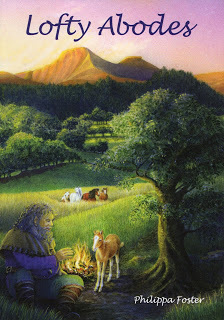 Front cover of
Lofty Abodes
by Philippa Foster (Text and cover artwork © Philippa Foster)
Front cover of
Lofty Abodes
by Philippa Foster (Text and cover artwork © Philippa Foster)Over the years, I have been very fortunate and privileged that a number of my cryptozoological articles and books have contained exquisite illustrations by the extremely talented artist Philippa Foster. One of her most beautiful and, indeed, spectacular artworks, featuring a pair of ethereal sky medusae, even featured on the front cover of one of my books, Dr Shuker's Casebook (2008).
Knowing of and sharing Philippa's abiding love of the countryside and all of nature's endearing, enduring works, as well as her interest in magical realms, I have wondered on more than one occasion whether one day she may venture beyond the art world and into the written word too during her depictions of these mutually fascinating subjects, and I'm delighted to say that recently she did indeed do so.
 Front cover of Dr Shuker's Casebook featuring sky medusae backdrop by Philippa Foster (© Dr Karl Shuker/CFZ Press; front cover artwork © Philippa Foster)
Front cover of Dr Shuker's Casebook featuring sky medusae backdrop by Philippa Foster (© Dr Karl Shuker/CFZ Press; front cover artwork © Philippa Foster)The result is an absolutely charming story for children entitled Lofty Abodes , written and published by Philippa, which I read a while ago and thoroughly enjoyed.
Set in the Brecon Beacons of Wales, and unfurling under the watchful eyes of the Red Sandstone Guardians, it weaves a magical, enchanted tale featuring both the familiar and also various cryptozoological creatures that make their home in this famously spectacular realm in Great Britain, from lonely trolls and friendly red kites to a glow worm city, rollicking rabbits, and a tantalising assortment of teasing puzzles and riddles too.
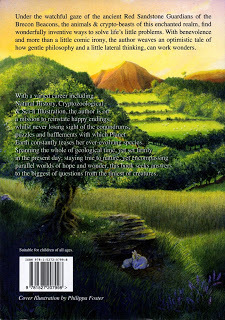 Back cover of
Lofty Abodes
by Philippa Foster (Text and cover artwork © Philippa Foster)
Back cover of
Lofty Abodes
by Philippa Foster (Text and cover artwork © Philippa Foster)Significantly, it also includes something that Philippa (and I) consider very important (but sadly all too rare nowadays) in books for youngsters – a happy ending. Why do children's authors seem obliged lately to include some gritty, heartless denouement to their stories? The real world is gritty and heartless enough – surely the whole point of fiction, especially children's fiction, is escapism, to flee from the hardships of existence if only for a little while by seeking the warm, comforting, uplifting solace of a story in which the world is a finer, happier place, where worries can be forgotten and dreams of a better land and life can be born, nurtured, and, who knows, possibly even retained and given substance to when their dreamers have returned to grim reality.
With Christmas rapidly approaching, it gives me great pleasure to introduce Lofty Abodes here on ShukerNature, as I am certain that it would make a delightful and much-treasured gift for children, and not just young ones but children of all ages, for anyone, in fact, who carries in their heart the joy and unadulterated love of nature and wild things that they first experienced as children. Copies can be purchased directly from Philippa via her website , and also here on Amazon's UK website when available there.

Published on November 20, 2018 10:12
November 6, 2018
BLACK-AND-WHITE ...AND WEIRD ALL OVER - SOLVING THE MYSTERY OF THE STRIPED MANTA RAYS
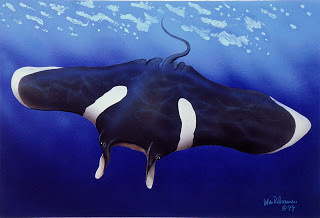 Magnificent painting portraying William Beebe's striped manta ray (© William M. Rebsamen)
Magnificent painting portraying William Beebe's striped manta ray (© William M. Rebsamen)In 1999, my book Mysteries of Planet Earth became the first cryptozoologically-oriented book to include a specific section on what must surely be one of the most strikingly beautiful mystery beasts ever reported, and its coverage was greatly enhanced by the inclusion of a spectacular full-colour painting of this animal - another first for it - prepared specially for my book by renowned cryptozoological artist William M. Rebsamen (and which also opens this present ShukerNature blog article). Neither of us realised at that time, however, that only a few years later I would actually witness just such an animal, and in a wholly unexpected manner. The following article – the most detailed that I have ever prepared on this particular subject and constituting a ShukerNature exclusive – contains not only all of the information that I included in my 1999 book but also various additional cases uncovered by me since then, including my own afore-mentioned observation. So where better to begin it than with that observation – and here it is.
On 20 July 2005, I was sitting in front of the television at home in the UK, flicking idly between channels, when I happened to click onto Channel 5, and within a few seconds beheld an extraordinary sight. The programme being screened was a documentary entitled 'Whale Shark: Journey of the Biggest Fish in the World'. However, the fish that I was staring at in amazement was anything but a whale shark. It was a giant manta ray Manta birostris - a huge, superficially nightmarish beast popularly dubbed a devil-fish (see also here ) due to its mouth's pair of demonic, horn-resembling, laterally-sited cephalic fins, and its huge batwing-like pectoral fins, uniformly dark on top, white below...except that this particular manta's pectorals were most definitely not uniformly dark on top. Instead, they were dramatically adorned by a longitudinal series of white v-shaped chevrons, and also sported pure white wing tips. This spectacular vision soared gracefully through its underwater domain for a few moments before the camera moved on to other subaqueous delights, and it did not appear again.
Not having tuned in to this programme from the beginning, I had no idea where the striped manta had been filmed, but the very next section of the documentary stated that the whale shark star of the show had now reached the Mozambique Channel, apparently having travelled there from the Seychellesregion of the Indian Ocean. So this may have been where the manta footage had been shot.
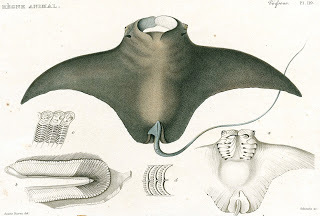 A typical, non-striped specimen of the giant manta ray, as depicted in an 18th/19th-Century illustration from Iconographia Zoologica (public domain)
A typical, non-striped specimen of the giant manta ray, as depicted in an 18th/19th-Century illustration from Iconographia Zoologica (public domain)What made this serendipitous sighting so notable was that for a great many years (right up to the time when I viewed the above-cited TV programme, in fact), mainstream zoology had tended not to recognise the existence of mantas other than the mundanely standard dark-dorsal, pale-ventral version. Yet there on screen was positive proof that at least one manta of a decidedly more flamboyant variety was indeed real. Nor was it unique. Several other specimens have been documented down through the decades, exhibiting a range of patterns, and spied in many different oceanic localities.
The earliest one that I have on record, and which remains the most famous (it was the subject of William Rebsamen's magnificent painting), was witnessed on 27 April 1923 by American naturalist William Beebe and several others while aboard his expedition vessel Noma, as it approached Tower Island in the Pacific Ocean's Galapagos archipelago. The manta ray briefly struck the side of the vessel and then sped swiftly away along the surface, providing its observers with an excellent view. According to Beebe, who later sketched it:
From tip to tip of wings it was at least ten feet, of somewhat the usual manta or devil-fish shape, except that the wings were not noticeably concave behind, and the lateral angles were not acute. The cephalic horn-like structures were conspicuous and more straight than incurved. In general the back was dark brown, faintly mottled, while the most conspicuous character was a pair of broad, pure white bands extending halfway down the back from each side of the head. The wing tips also shaded abruptly into pure white.
Documenting this dorsally-bicoloured manta in his book Galapagos: World's End (1924), Beebe considered that it may represent an unknown species.
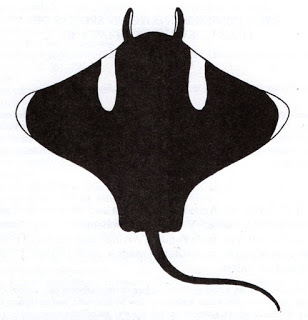 Beebe's sketch of the striped manta ray observed by him off the Galapagos archipelago's Tower Island in 1923 (public domain)
Beebe's sketch of the striped manta ray observed by him off the Galapagos archipelago's Tower Island in 1923 (public domain)In Vol. 12 of the now-defunct International Society of Cryptozoology's scientific journal Cryptozoology (covering the period 1993-1996), German researcher Gunter G. Sehm's paper on striped manta rays surveyed some other specimens. In 1924, fr example, a small manta was harpooned off the shore reef at Kiribati's Fanning Island(renamed Tabuaeran). Its dorsal surface was blue-black but also bore two large ash-coloured v-shaped chevrons that spanned the entire dorsum from left pectoral edge to right. In 1934 this specimen was deemed a new species and dubbed Manta fowleri, but its separate taxonomic status is no longer recognised.
In 1975, British Museumichthyologist Alwyne Wheeler's book Fishes of the World contained a colour photograph of a manta ray that appeared to have some white striping on its right shoulder, although few details can be discerned because the picture had been taken side-on. A year later, a book by Pierre Fourmanoir and Pierre Laboute detailing the fishes native to the waters around New Caledonia and the New Hebrides included a colour photo of a manta ornately adorned with dorsal white banding and cephalic fins. In his paper, Sehm also included three hitherto-unpublished stills from a 30-second footage of film showing a manta with a pair of striking, laterally-sited, v-shaped dorsal markings, filmed off the coast of Mexico's Baja California by Sigurd Tesche, which had been broadcast by German TV on 28 December 1989 within a programme entitled 'Sharks: Hunters of the Seas'.
Correspondent Alan Pringle contacted me shortly after watching, on 7 November 1999, aBBC1 television programme 'Holiday Guide to Australia', to inform me that it had contained a snippet of film depicting a manta with two converging longitudinal dorsal white bands, filmed from above by a helicopter, as it swam above a reef in Australia's Great Barrier Reef.
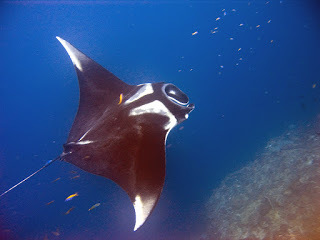 A striped giant manta ray at Hin Daeng, Thailand, on 30 November 2005 (© Jon Hanson/Wikipedia –
CC BY-SA 2.0 licence
)
A striped giant manta ray at Hin Daeng, Thailand, on 30 November 2005 (© Jon Hanson/Wikipedia –
CC BY-SA 2.0 licence
)I learnt from fellow crypto-enthusiast Matt Bille that on 19 September 2003, yet another striped manta made an unexpected television appearance, this time in the American reality game show 'Survivor', when a manta ray sporting a very prominent pair of white shoulder markings, resembling filled-in triangles along the body, cruised fleetingly just under the clear waters off Panama's Pacific coast.
Not long after my own television sighting in July 2005, I was informed of two separate webpages each containing a colour photograph of a striped manta. One of these, which still appears here , shows a manta with symmetrical lateral chevrons resembling those of the Baja California individual, but it also has white rings around its cephalic fins, a pale patch at the dorsal tip of its left pectoral fin (its right cannot be seen dorsally), and what looks like a white dorsal tail surface. More photos of it have since appeared on Wikipedia and elsewhere online, confirming that it does have a white patch at the dorsal tip of its right pectoral fin too. It was photographed at Hin Daeng, off Thailand.
The other page (no longer directly online at http://www.accessnoaa.noaa.gov/images... but still accessible here - thanks to the Wayback Machine Internet Archive) – in a website run by America's National Oceanic and Atmospheric Administration (NOAA) - showed an ornately-marked specimen with very extensive white wing tips linked posteriorly by a pair of white converging arcs, as well as white cephalic fins. No details of where this photo was taken were given.
 The striped manta ray photograph formerly directly visible online in America's NOAA site (© NOAA – reproduced here on a strictly non-commercial Fair Use basis for educational and review purposes only)
The striped manta ray photograph formerly directly visible online in America's NOAA site (© NOAA – reproduced here on a strictly non-commercial Fair Use basis for educational and review purposes only)In short, a diverse spectrum of striped mantas is on record, with no two alike, but collectively confirming that dorsally bicoloured individuals do indeed exist. So how can they be explained? Interestingly, some of them, notably Beebe's specimen, the Fanning Island manta, and the Baja California example, have conspicuously shorter-than-typical tails, and also the shape of their pectorals do not exhibit such marked convexity of the front edge and concavity of the trailing edge as those of 'normal' mantas do, leading Sehm to consider the possibility that these represent a separate taxonomic form. Equally, however, sometimes genes linked to colour or body pattern also influence the size or shape of an individual (pleiotropic genes), so there is no guarantee that these morphological differences have independent significance.
Moreover, it is known that attacks by other fishes can leave white marks on the dark dorsal surface of a manta. In fact, its dark pigment can even be removed merely by rubbing the surface, creating pale patches. And the elasmodiver website's manta page states that the wing tips often fade to white. Worth noting, incidentally, is that back in the early 2000s this latter site was one of the very few mainstream sources that openly acknowledged the existence of striped mantas, stating at that time: "Dorsum black or dark often with symmetrical white patches forming a chevron across the shoulders".
Intriguingly, Sehm attempted to explain away the white wing tips of Beebe's specimen as an illusion, claiming that what Beebe and his colleagues saw was the white undersurface of the wing tips upraised, fooling the observers into thinking that the dorsal wing tips were white. However, I do not believe this interpretation - the NOAA website's manta unequivocally possesses white dorsal wing tips, as did the specimen that I watched in the whale shark film. Instead, judging from the elasmodiver website's comments, it may be that white-tipped mantas are aged specimens. However, so precise is the symmetry of the white markings on all specimens of striped manta, whether they be wing tip markings, shoulder markings, or chevrons, that this seems unlikely - as do, for the same reason, explanations invoking injury or rubbing as the source of such markings.
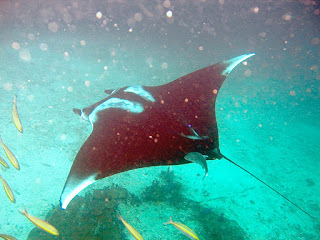 A striped manta ray at Hin Muang, Thailand on 30 November 2005 (© Jon Hanson/Wikipedia –
CC BY-SA 2.0 licence
)
A striped manta ray at Hin Muang, Thailand on 30 November 2005 (© Jon Hanson/Wikipedia –
CC BY-SA 2.0 licence
)In 2005, within a Fortean Timesarticle of mine devoted to these mystery mantas, I expressed the view is that a mutant gene allele was most probably responsible, engendering on rare occasions these stunning and sometimes quite elaborate patterns in mantas - analogous, perhaps, to black-and-white specimens of blackbirds, black bears, crows, and other normally monochromatic species, and creating an additional vision of wonder and mystery amid the breathtaking splendour present beneath the surface of our planet's mighty seas.
Sure enough, thanks to observations and photographs taken of many additional specimens since then, the existence of striped manta specimens is nowadays not only universally accepted among ichthyologists but also, far from constituting a separate species, is deemed to be nothing more than an expression of individual non-taxonomic variation within the long-recognised giant manta species Manta birostris.
Unrelated to such considerations but still worth noting, however, is that in 2009, asecond, somewhat smaller, and non-migratory manta ray species, the reef manta M. alfredi, was officially distinguished, named, and formally described – see my Encyclopaedia of New and Rediscovered Animals , 2012, for more details.
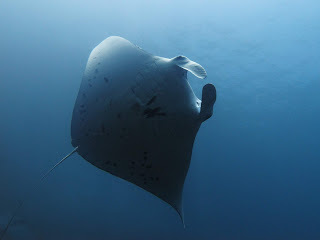 A reef manta ray at Manta Alley, near Komodo, Indonesia, in September 2010 (© Alexander Vasenin/Wikipedia –
CC BY-SA 3.0 licence
)
A reef manta ray at Manta Alley, near Komodo, Indonesia, in September 2010 (© Alexander Vasenin/Wikipedia –
CC BY-SA 3.0 licence
)But this is not all. In autumn 2014, amainstream ichthyological discovery was made public via a scientific paper that revealed an exceedingly significant but hitherto entirely unsuspected aspect concerning the true nature of striped mantas. Ironically, however, this crucial find has attracted relatively little attention, especially in cryptozoological circles. Indeed, as far as I am aware, the following documentation of it by me is the first time that this remarkable discovery has ever been referred to in such a capacity, even though it holds the key to these distinctive fishes' very existence.
Published by the Biological Journal of the Linnean Society on 1 September 2014, the paper in question (click here to read it in its entirety) was authored by Csilla Ari, from the University of South Florida's Hyperbaric Biomedical Research Laboratory, and revealed for the very first time that giant manta rays possess the ability to change colour and pattern at will. Ari's study showed that a manta's typical (or, as termed in the study, its baseline) colouration state (i.e. its dark dorsal surface) can change rapidly at feeding times, or if it encountered another manta ray in close proximity to itself, or during intense social interaction between itself and another manta ray. And the precise nature of this colour change was a very noticeable increase in the brightness of hitherto pale, inconspicuous shoulder and pectoral wing tip markings.
In other words, when faced with any of the three situations listed above, a typical dorsally dark manta would transform directly into a striped manta!
 A striped manta ray encountered at South Point, Pulau Sipadan, off the Malaysian state of Sabah on Borneo, in February 2010 (© Bernard Dupont/Wikipedia –
CC BY-SA 2.0 licence
)
A striped manta ray encountered at South Point, Pulau Sipadan, off the Malaysian state of Sabah on Borneo, in February 2010 (© Bernard Dupont/Wikipedia –
CC BY-SA 2.0 licence
)Here is the principal Results paragraph excerpted from Ari's paper, detailing this extraordinary manta metamorphosis with reference to various 'before' and 'after' photographs of the mantas (these photos can be viewed directly if the paper is accessed using the above link):
Captive manta rays were observed to undergo rapid changes (within a few minutes) in their body coloration. Specifically, white markings appeared and changed intensity on certain body regions (Fig. 1, 2, 3, 4; the two most representative specimens from each species are shown). The intensity of the white markings would increase rapidly to the ‘intense coloration state’ (Fig. 1D, E, F, G, H, 2D, E, F) more times during the day within a few minutes, and then return to the normal ‘baseline coloration state’. Changes in coloration were observed to occur in temporal proximity to a variety of situations, including at feeding times (Fig. 1H), whenever a new manta ray was introduced to the tank, and during intense social interaction between the two manta rays (Fig. 1G). Feeding occurred twice a day and the rapid coloration changes started shortly (5–10 min) before each feeding on both specimens. The ‘intense coloration state’ was most intense during feeding and slowly returned to the ‘baseline coloration state’ over a period of 20–30 min after the end of the feedings. In addition, rapid coloration changes were observed in association with intense social interaction; for example, when Manta 2 was introduced into the tank or when mantas were chasing each other rapidly and closely, which appeared to comprise courtship behaviour.
In short, the striped manta state was not even a permanent one. Consequently, it would appear that in most if not all cases, such mantas that have been reported and photographed in the past were nothing more than normal mantas exhibiting the temporary pattern and colour transformation ability that had been discovered for their species by Ari. (Incidentally, Ari also revealed that reef mantas possess this same ability.)
The mystery of the striped mantas is a mystery no longer. True, there may be occasional specimens that do exhibit such markings on a permanent basis as an expression of individual variation, but in most cases such markings would seem to be merely a temporary feature, induced on a non-permanent basis by various fluctuating external factors.
Finally: even though we now know the secret of the striped mantas, it is still thrilling when one of these spectacular creatures turns up unexpectedly – and that is precisely what happened to me a second time just last night. I had been watching the 2016 Disney cartoon film Moana, whose storyline was inspired by traditional Polynesian mythology and featured the famous demi-god Maui, when suddenly, in a split-second segment right at the end of the film, an animated striped manta sporting a vivid pair of white shoulder bars and pectoral wing tips soared majestically through the water just beneath the surface. A fitting finale, assuredly, for a movie of magic and mythology to feature a maritime denizen so long associated with mystery and mystification.
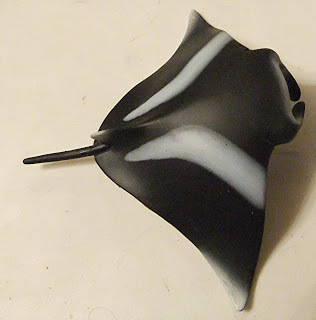 My very own striped manta ray – a model of one that I purchased at London Zoo in September 2014 (© Dr Karl Shuker/London Zoo)
My very own striped manta ray – a model of one that I purchased at London Zoo in September 2014 (© Dr Karl Shuker/London Zoo)
Published on November 06, 2018 15:38
October 24, 2018
SEEKING THE SHAMANU - IS JAPAN'S LITTLE HOWLING GOD TRULY EXTINCT?
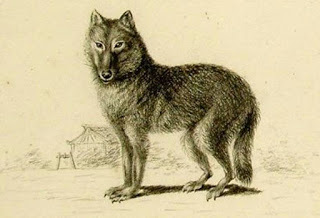 Carl Hubert de Villeneuve's sketch of German botanist Philipp Franz von Siebold's captive shamanu, which he had purchased in 1826; sketch produced sometime during 1826-1830 (public domain)
Carl Hubert de Villeneuve's sketch of German botanist Philipp Franz von Siebold's captive shamanu, which he had purchased in 1826; sketch produced sometime during 1826-1830 (public domain)According to traditional mainstream zoology, the shamanu or Japanese dwarf wolf Canis lupus hodophilax was, as its names suggest, a noticeably small subspecies of grey wolf indigenous to Japan (specifically the islands of Honshu, Kyushu, and Shikoku, but not Hokkaido – where a second, much larger grey wolf subspecies, C. l. hattai, once existed instead) but not otherwise significant from an evolutionary standpoint, and was hunted into extinction in 1905.
During September 2018, however, some startling news emerged that very emphatically overturned the first of these two longstanding assumptions.
 Taxiderm shamanus at Ueno Zoo, Tokyo (© Katuuya/Wikipedia –
CC BY-SA 3.0 licence
)
Taxiderm shamanus at Ueno Zoo, Tokyo (© Katuuya/Wikipedia –
CC BY-SA 3.0 licence
)For that was when, during the International Symposium on Biomolecular Archaeology, held at Jena in Germany, graduate student Jonas Niemann from Denmark's University of Copenhagen revealed that after he and a team of fellow researchers had analysed the genome of a shamanu skeleton from London's Natural History Museum, they had made the startling, highly unexpected discovery that its DNA more closely resembled that of a long-extinct wolf that had lived in Siberia over 35,000 years ago than that of living Eurasian and American wolves, and that the shamanu therefore appeared to be a modern-day relic of an ancient, ostensibly long-vanished group of wolves that had once ranged across the Northern Hemisphere but had hitherto been deemed to have become extinct around 20,000 years ago.
As commented upon by paleogeneticist Mikkel Sinding from the Greenland Institute of Natural Resources in Nuuk, who had extracted the DNA from the shamanu skeleton, this remarkable disclosure could offer a new window on the evolution of wolves, as well as dogs.
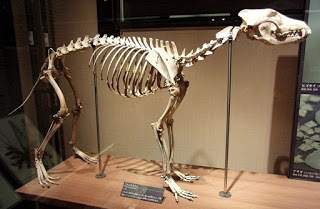 Shamanu skeleton, in the National Museum of Nature and Science, Tokyo, Japan (© Momotarou2012/Wikipedia –
CC BY-SA 3.0 licence
)
Shamanu skeleton, in the National Museum of Nature and Science, Tokyo, Japan (© Momotarou2012/Wikipedia –
CC BY-SA 3.0 licence
)Suddenly, a long-held belief regarding the shamanu was no more. But this is not all. Might the second traditional shamanu tenet – that this veritable bonsai wolf became extinct in 1905 – also be disproved one day?
This is by no means impossible, because long after that fateful year, eyewitness reports of small, mysterious wolf-like creatures in various regions of Japan have continued to emerge, encouraging some investigators to become cautiously optimistic that the shamanu may indeed still persist.
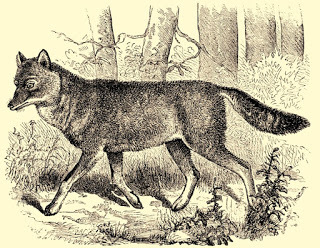 Shamanu engraving, from Cambridge Natural History, Mammalia, 1902 (public domain)
Shamanu engraving, from Cambridge Natural History, Mammalia, 1902 (public domain)I first became aware of and interested in this exciting possibility back in the 1990s, and after researching it I penned an article on the subject, which was duly published in the August 1997 issue of the now long-defunct British monthly magazine All About Dogs (and contained a delightful colour drawing of a shamanu by Philippa Coxall (now Foster), who illustrated many magazine articles of mine during that decade). As this article may not have ever been seen by readers outside Europe, however, I am reprinting it herewith as a ShukerNature exclusive. Please click on each of its pages to expand it for reading purposes.
(NB – Since I wrote that article, it has been shown that the Arab wolf C. l. arabs is slightly smaller on average than the shamanu, so the latter is no longer deemed to be the world's smallest subspecies of grey wolf; and the shamanu is no longer believed to have existed on Hokkaido.)
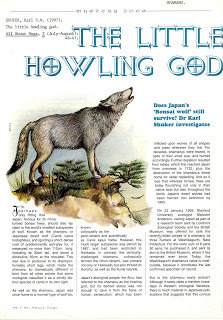
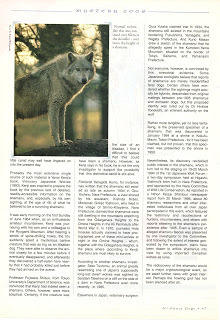 My All About Dogs article, of August 1997, concerning the possible survival of the shamanu (© Dr Karl Shuker)
My All About Dogs article, of August 1997, concerning the possible survival of the shamanu (© Dr Karl Shuker)My article attracted sufficient interest from readers to inspire me to continue researching this fascinating subject, and in my book The Beasts That Hide From Man (2003) I added some further, more recent information, which reads as follows:
In January 1997, a significant new piece of evidence for the shamanu's putative survival was publicised - a series of recent photographs depicting a dog-like beast that bears a startling similarity to a living shamanu. The photos were snapped on 14 October 1996 by 47-year-old Hiroshi Yagi in the mountain district of Chichibu. He had been driving a van along a forestry road that evening when a short-legged dog-like beast with a black-tipped tail suddenly appeared further down the road. A longstanding shamanu seeker, Yagi reached for his camera, but the animal vanished. After driving back and forth along the road in search of it, however, Yagi saw it again, and this time was able to take no fewer than 19 photos from just a few feet away. He even threw a rice cake towards it, hoping to tempt it closer still, but the creature turned away and disappeared into a forest. When the pictures were examined by eminent Japanese zoologist Prof. Imaizumi Yoshinori, he felt sure that the animal was indeed a shamanu.
In November 2000, Akira Nishida took a photo of a canine mystery beast on a mountain in Kyushu that was widely acclaimed afterwards as evidence of shamanu survival - until March 2001, that is. For that was when a sign appeared on a hut on Ogata Mountain claiming that the creature in the photo was nothing more than a Shikoku-region domestic dog that the hut's owner had been forced to abandon for private reasons. However, Yoshinori Izumi, a former head of the National Science Museum's animal research section, dismisses this claim as a hoax, and remains adamant that the photographed canid is a bona fide shamanu, even stating that the pattern of the creature's fur is completely different from that of Shikoku dogs. This is evidently a saga with many more chapters still to be written!
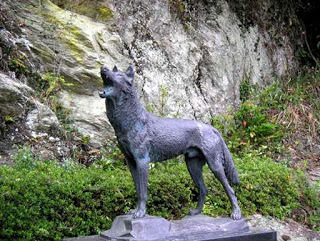 Japan's very poignant, official memorial statue to the shamanu, which stands by the banks of the Takami River in Higashiyoshino, Nara, and is a replica of the last confirmed individual killed by hunters nearby in 1905. Inscribed is the haiku: I walk/ With that wolf/ That is no more. (© Katuuya/Wikipedia –
CC BY-SA 3.0 licence
)
Japan's very poignant, official memorial statue to the shamanu, which stands by the banks of the Takami River in Higashiyoshino, Nara, and is a replica of the last confirmed individual killed by hunters nearby in 1905. Inscribed is the haiku: I walk/ With that wolf/ That is no more. (© Katuuya/Wikipedia –
CC BY-SA 3.0 licence
)I have recently discovered online an extensive scientific paper analysing the photographs snapped by Hiroshi Yagi of the so-called Chichibu wild dog, as this mystery canid has since become known. Authored by him and Japanese scientist Masazumi Morita, and published by the Japanese journal Animate in 2015, its findings indicate that the creature may indeed have been a shamanu, as revealed by the paper's summary:
Nineteen photographs of an animal "Chichibu wild dog" were taken on 14th October 1996 at the Chichibu mountains. Four of photos that captured artificial structures on the same picture, were analyzed for determination of body, head and face sizes. The estimated sizes were similar to those of a specimen of the Japanese wolf, Canis hodophilax that went extinction in 1905. Based on the results, we applied the super-impose method between the photos of head or whole body and skeletal photos of C. hodophilax specimen. The results showed that the photographed animal approximated to C. hodophilax specimen with appearance, size and shape. It indicated that a canine animal similar to C. hodophilax was present in 1996.
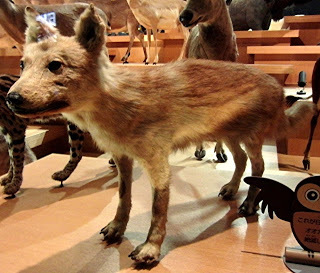 Taxiderm shamanu, in the National Museum of Nature and Science, Tokyo, Japan (© Momotarou2012/Wikipedia – CC BY-SA 3.0 licence)
Taxiderm shamanu, in the National Museum of Nature and Science, Tokyo, Japan (© Momotarou2012/Wikipedia – CC BY-SA 3.0 licence)I haven't read any reports of putative shamanu survival lately, but in view of this enigmatic little canid's elevated evolutionary significance and recent outing as a prehistoric survivor of sorts, perhaps it's time that I took up its case once more to seek out and publicise any new sightings and accounts that may be on record.
So, watch this space!
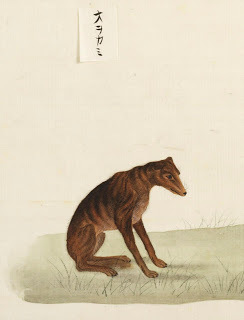 Shamanu illustration by Kawahara Keiga, produced sometime during 1823-1829 (public domain)
Shamanu illustration by Kawahara Keiga, produced sometime during 1823-1829 (public domain) Finally: it is nothing if not ironic that perhaps the best known shamanu illustration may not actually portray a shamanu at all. In 1826, German botanist Philipp Franz von Siebold purchased two living canids. One was a genuine shamanu (and was unequivocally depicted by Carl Hubert de Villeneuve (his depiction of it opens this present ShukerNature article), the other was an adult female specimen of a strain of domestic dog familiar in Japan and referred to variously as the yamainu or mountain dog. He made detailed notes and sketches of the two animals, taking pains to delineate their morphological differences.
Notwithstanding this, however, when Dutch zoologist Coenraad Jacob Temminck subsequently consulted Siebold's notes while preparing his own documentation of the shamanu for his great work Fauna Japonica (1833), he somehow confused the two different canids, ultimately synonymising them as one and the same form. Consequently, there has been much controversy and conjecture ever since as to whether the shamanu illustration in his work does indeed depict a shamanu or whether it is instead based upon the mountain dog. Nevertheless, this image has been reproduced and presented as a bona fide shamanu representation in many later publications, making it the most (in)famous shamanu picture ever.
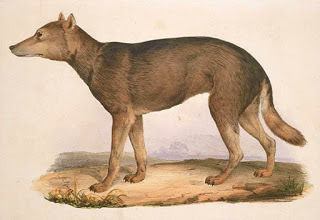 Illustration of a possible shamanu but more probably just a yamainu or mountain dog, in Dutch zoologist Coenraad Jacob Temminck's Fauna Japonica, 1833 (public domain)
Illustration of a possible shamanu but more probably just a yamainu or mountain dog, in Dutch zoologist Coenraad Jacob Temminck's Fauna Japonica, 1833 (public domain)
Published on October 24, 2018 18:23
September 24, 2018
CONTINENT-SWAPPING WITH THE BOGOTA CAT AND WARWICK'S CAT
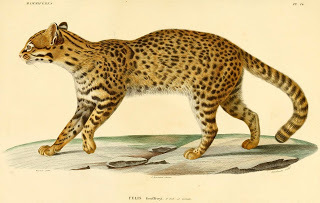 Geoffroy's cat – the doubly-deceiving feline bête noire of British zoologist John Edward Gray; illustration from Alcide Dessalines d'Orbigny's
Voyage dans l'Amérique Méridionale
, published in 1847 (public domain)
Geoffroy's cat – the doubly-deceiving feline bête noire of British zoologist John Edward Gray; illustration from Alcide Dessalines d'Orbigny's
Voyage dans l'Amérique Méridionale
, published in 1847 (public domain)During the course of zoological history, mistakes have sometimes been made when recording the provenance of an animal specimen, often resulting in all manner of confusion and controversy. Fortunately, the mistake is generally nothing more dramatic than a wrongly-noted locality within a given country, or, more rarely, a wrongly-ascribed country. It is quite exceptional, however, for a specimen to be assigned to entirely the wrong continent. Nevertheless, this monumental error happened with both of the short-lived felid species documented here - and, to make matters even worse, it was the same well-respected zoologist who was responsible for having done so in each case!
On 11 April 1867, within a Proceedings of the Zoological Society of London paper, eminent British zoologist Dr John Edward Gray formally described and named several new species of felid, based upon specimens in the collection of the British Museum. One of these new species was Felis pardinoides, whose type specimen was the preserved skin and skull of a juvenile individual that had been received by the British Museum from the Zoological Society's own museum. According to its provenance label, it had been obtained in India by a Captain Innes. A small spotted cat, its head and body length was 19 inches, and its tail length was 9 inches.
 This present ShukerNature blog article's principal personae dramatis - from left to right: John Edward Gray, Daniel G. Elliot, Edward Blyth, Philip L. Sclater (public domain)
This present ShukerNature blog article's principal personae dramatis - from left to right: John Edward Gray, Daniel G. Elliot, Edward Blyth, Philip L. Sclater (public domain)Everything seemed perfectly straightforward and unremarkable concerning F. pardinoides – until 20 February 1872, that is, when the following revealing response to Gray's description, penned by fellow zoologist and cat specialist Daniel G. Elliot, was received by the PZSL and duly published:
In the 'Proceedings' of this Society for 1867, p. 400, Dr. Gray has described a Cat as Felis pardinoides, giving as its habitat India. The typical [i.e. type] specimen is evidently not an adult animal; and from its resemblance to F. geoffroyi [Geoffroy's cat, nowadays known scientifically as Leopardus geoffroyi], I felt certain, while examining it, that its habitat was not correctly given. During my late visit to Leyden I found another specimen of a Cat, almost precisely similar to Dr. Gray's type, marked as F. geoffroyi, and stated to have been brought from Patagonia, the native country of that species. This Leyden specimen (which is also that of a young animal) by the kindness of Prof. Schlegel I have been enabled to remove to London, and thus to identify with the so-called F. pardinoides. The young F. geoffroyi appears to differ from the adult in the larger size and somewhat different arrangement of the spots, those upon the sides, shoulder, and rump being, as Dr. Gray describes them, "varied with grey hairs in the centre, making them appear somewhat as if they were formed of a ring of smaller black spots." But the general colours of the animal, with its lengthened annulated tail, is precisely that of typical F. geoffroyi.
Suddenly, India's F. pardinoides had seemingly metamorphosed into the already-described F. geoffroyi from Patagonia – in South America! Gray, however, did not agree with Elliot's conclusion; and in a concise response published in the Annals and Magazine of Natural History for 1874, he sought to distinguish various morphological and cranial differences between his species and Geoffroy's cat.
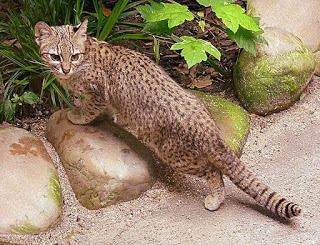 Geoffroy's cat (© Daf-de/Wikipedia –
CC BY 2.5 licence
)
Geoffroy's cat (© Daf-de/Wikipedia –
CC BY 2.5 licence
)Clearly, Elliot's radical re-identification would only be conclusively accepted if a more mature F. geoffroyi specimen that was visibly conspecific with the lone F. pardinoides example were to be found and documented accordingly. Shortly after Gray's response was published, however, this is precisely what happened, and by none other than Gray himself, as he revealed in a second response published within a later issue of the very same journal for 1874:
The Bogotá Cat (Felis pardinoides, Gray).
In the 'Annals' for 1874, xiii, p. 51, I gave the reasons for differing from Mr. Elliot's opinion that the cat I named Felis pardinoides in the British Museum, received from the Zoological Society as coming from India, was the same as Felis Geoffroyi[sic]. At the same time I observed, "the Indian habitat has not been confirmed; and the species has a very South-American aspect."
The British Museum has received, from Mr. Edward Gerrard, a cat from Bogotá that I have no doubt is the same species as the typical specimen of Felis pardinoides; but it differs from it in being a nearly adult specimen, as is proved by the examination of the skull; and it has a more fulvous tint, and the fur is softer; but this may only depend upon the age and season in which it was killed.
Thus ended the odd little history of India's non-existent F. pardinoides. What makes this such an ironic (and embarrassing) episode for Gray, however, is that he had already made an almost identical error only a short time earlier with another wrongly-labelled felid specimen, giving rise to the equally ephemeral species Pardalina warwickii - Warwick's cat.
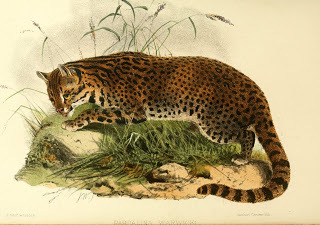 Warwick's cat, illustrated by Joseph Wolf in 1867 (public domain)
Warwick's cat, illustrated by Joseph Wolf in 1867 (public domain)As already noted, Felis pardinoides was one of several new cat species formally described and named by Gray in his PZSL paper of 11 April 1867. Another one (the very last in it, in fact) was Pardalina warwickii. In addition to his own short verbal description of this species' type specimen, Gray included the magnificent colour plate reproduced here, reconstructing its likely appearance when alive, and painted by celebrated wildlife artist Joseph Wolf. As for the specimen itself, Gray preceded his description of it with the following explanatory account of its mysterious history:
There is in the British Museum a Cat that was formerly alive in the Surrey Zoological Gardens, and was there called the Himalayan Cat, and which, in the 'List of Mammalia in the British Museum,' published in 1842, I called Leopardus himalayanus. This animal is figured, from the specimen at the Surrey Zoological Gardens, in Jardine's 'Naturalist's Library' as Felis himalayanus, Warwick. The figure is by no means a characteristic one. The Cat has not been brought from Himalaya by any of the numerous sportsmen and collectors that have searched that country. It is not known to Mr. Blyth [prominent 19th-Century zoologist Edward Blyth], nor to any other Indian zoologist to whom I have shown it; indeed Mr. Blyth states that he believes it to be a South American Cat.
The examination of the skull shows that it forms a group by itself; and in my paper, read at the last Meeting but one, I formed for it a genus under the name of Pardalina.
This enigmatic specimen, of supposed Himalayan provenance, had been obtained by a Mr Warwick, whom Gray duly honoured by naming its new species after him, but nothing more precise regarding its early history seems to be on record.
 Two typical, golden-furred specimens (top and bottom left) of the African golden cat plus a specimen of this same species' grey-furred 'silver cat' morph (bottom right) (public domain)
Two typical, golden-furred specimens (top and bottom left) of the African golden cat plus a specimen of this same species' grey-furred 'silver cat' morph (bottom right) (public domain)Conversely, several years before Gray's 1867 PZSL paper had even been published, Warwick's cat had already begun inciting controversy regarding its taxonomic identity. In a PZSL paper of 1863, English zoologist Edward Blyth had deemed it possible that this unusual specimen was actually a silver cat Felis celidogaster – a species that he in turn considered to be conspecific with the fishing cat Felis viverrina. (In reality, the silver cat was subsequently shown to be nothing more than a colour morph of the African golden cat Caracal aurata.)
In stark contrast, Gray strongly disagreed with Blyth's classification of Warwick's cat, noting in his own PZSL paper of 1867 that its skull was very different from that of the fishing cat. In particular, he stressed the length of its brain case, the shortness of its face, and the convexity of its brow. As with F. pardinoides, however, it was not long after that latter paper had been published before the perplexing Pardalina was put under independent scrutiny, and Gray's statements were found to be very wanting in both the taxonomic and the zoogeographical departments.
 Fishing cat (© Viksah626/Wikipedia –
CC BY-SA 4.0 licence
)
Fishing cat (© Viksah626/Wikipedia –
CC BY-SA 4.0 licence
)In 1870, the Zoological Society's secretary, zoologist Philip L. Sclater, published a paper in its Proceedings that revealed the origin of Warwick's cat to have been far removed indeed from the Himalayas. In fact, it had been purchased alive from a Captain Hairby in Buenos Aires, Argentina, and had originated either in Paraguay or in Patagonia! Once again, a supposed Asian cat had been shown to be of South American extraction – but that was not the end of the unfortunate parallels in erroneous documentation between Warwick's cat and F. pardinoides, because studies of the former's type specimen exposed it to be none other than another specimen of Geoffroy's cat!
Once again, therefore, in 1874, and in the very same volume of the very same journal in which he had recanted his opinion concerning the identity of F. pardinoides, Gray now did the same regarding Pardalina warwickii – reprising in his own defence his earlier statements concerning the absence of reports of such a cat in the Himalayan region and the craniological reasons why he deemed the specimen distinct enough to warrant its own genus. He also explained that because it was supposedly a Himalayan cat, he had never thought to compare it with specimens of Geoffroy's cat or, indeed, of any other South American felid.
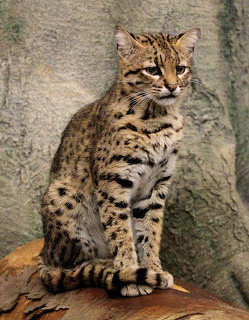 Geoffroy's cat (© Greg Hume/Wikipedia –
CC BY-SA 3.0 licence
)
Geoffroy's cat (© Greg Hume/Wikipedia –
CC BY-SA 3.0 licence
)But where did the notion come from that it had originated in the Himalayas anyway? This was Gray's answer:
When this cat was alive it was just the time that we began to receive fine skins of animals from the Himalayas; and there was an inclination of the dealers to give Himalaya as the habitat of animals of which they did not know whence they came, as animals from that country were interesting and fetched a good price...it has been suggested by Mr. Blyth and others that it may be an inhabitant of South America; but I have not seen any specimens from there.
Poor Dr Gray – whereas some people superstitiously believe it to be black cats or white cats that bring bad luck, in his case it was most definitely Geoffroy's cat!
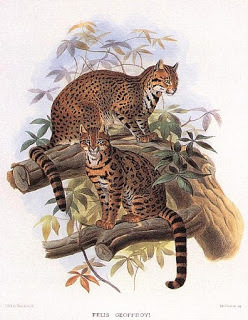 Exquisite painting from 1883, depicting coat pattern variation in Geoffroy's cat (public domain)
Exquisite painting from 1883, depicting coat pattern variation in Geoffroy's cat (public domain)Indeed, it is fortunate that Oscar Wilde's formidable literary creation, Lady Bracknell, was both fictitious and unassociated with feline systematics – otherwise, in her usual terrifyingly acerbic manner, she might well have observed: "To misplace one cat may be regarded as a misfortunate. To misplace two looks like carelessness."!!
This ShukerNature blog article is excerpted from my book Cats of Magic, Mythology, and Mystery .
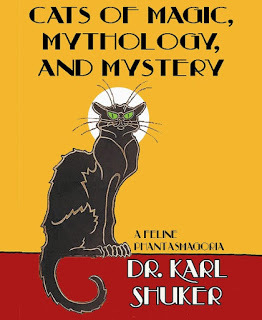
Published on September 24, 2018 18:35
September 9, 2018
GOING WILD OVER GWR'S 'WILD THINGS' – THE ANIMAL WORLD'S MOST AMAZING RECORD-BREAKERS IN AN AWESOME NEW BOOK!
 Guinness World Records: Wild Things
(© Guinness World Records/
GWR: Wild Things
)
Guinness World Records: Wild Things
(© Guinness World Records/
GWR: Wild Things
)In addition to the 26 books that I have written myself and seen published (#26 is due out shortly), I have also acted as a consultant and/or contributor to a further 18 – click here to access a (currently) complete listing of all of my books.
I am delighted to announce that the latest volume with which I have been involved in the dual capacity of consultant and contributor will be published next month but can already be pre-ordered on Amazon USA , Amazon UK , and elsewhere. It is entitled Guinness World Records: Wild Things , and here is a taster of what to expect:
Whether it's the biggest, the smallest, the fastest, the deadliest, or just the downright weirdest, Guinness World Records: Wild Things turns the spotlight on the best of the beasts! From gentle giants to killer bugs, powerful predators to cunning prey, and backyard wildlife to species on the brink, the animal kingdom is crawling with record-breakers.
 Spread featuring an interview with Steve Backshall - click image to enlarge for reading purposes (© Guinness World Records/
GWR: Wild Things
)
Spread featuring an interview with Steve Backshall - click image to enlarge for reading purposes (© Guinness World Records/
GWR: Wild Things
)Wild Things is your ultimate guide to nature's super-star animals. There's a special chapter all about prehistoric record-breakers too. Unearth which ancient animals ruled over the real Jurassic world, from the tallest dinosaur and the dino with the most powerful bite to the largest flying creature ever to soar Earth's skies with a wingspan the size of an F-16 jet!
You'll also hear from zoology experts and some of the biggest conservation stars including Sir David Attenborough, Dr Jane Goodall, the Irwin family, and Deadly 60's Steve Backshall (who supplies a foreword too). In exclusive interviews, they share their standout wildlife experiences, favourite record-breaking animals, plus top tips for anyone hoping to follow in their footsteps.
Ready to find out where the real wild things are and the records that they hold? Then it's time to unleash the wildest GWR book yet!
 My profile in
GWR: Wild Things
's Introduction - click image to enlarge for reading purposes (© Guinness World Records/
GWR: Wild Things
)
My profile in
GWR: Wild Things
's Introduction - click image to enlarge for reading purposes (© Guinness World Records/
GWR: Wild Things
)Full details can be found on this book's dedicated page here on my official website, which also contains direct clickable links to its page on the US and UK Amazon sites.
Also, don't forget to check out on my website its companion volume, GWR: Amazing Animals , published last year and once again featuring me as both its consultant and a contributor, which is packed throughout with fascinating record-breaking animal stars of the domesticated kind!
And click here to read about GWR: Amazing Animals on ShukerNature.
 Guinness World Records: Amazing Animals
(© Guinness World Records/GWR: Amazing Animals)
Guinness World Records: Amazing Animals
(© Guinness World Records/GWR: Amazing Animals)
Published on September 09, 2018 18:11
Karl Shuker's Blog
- Karl Shuker's profile
- 45 followers
Karl Shuker isn't a Goodreads Author
(yet),
but they
do have a blog,
so here are some recent posts imported from
their feed.



